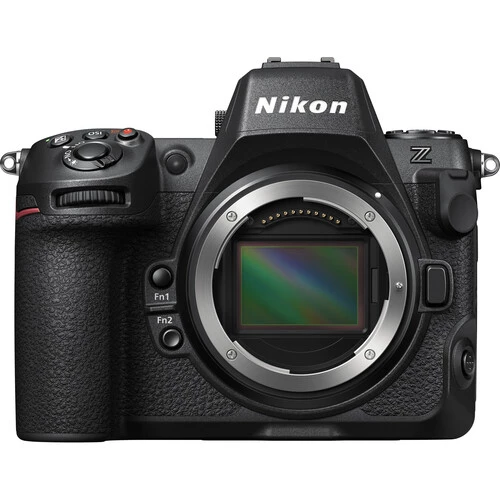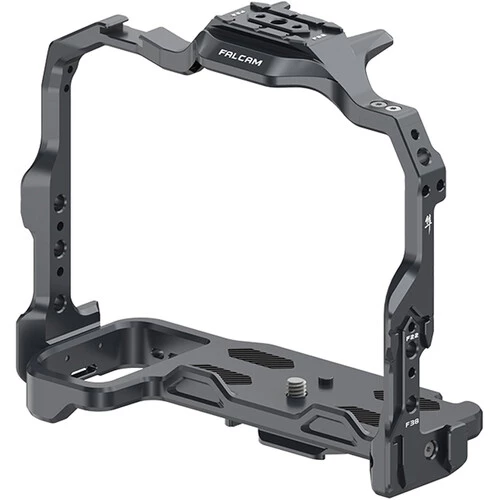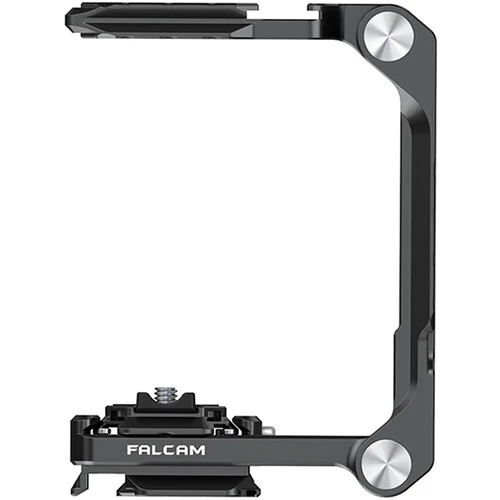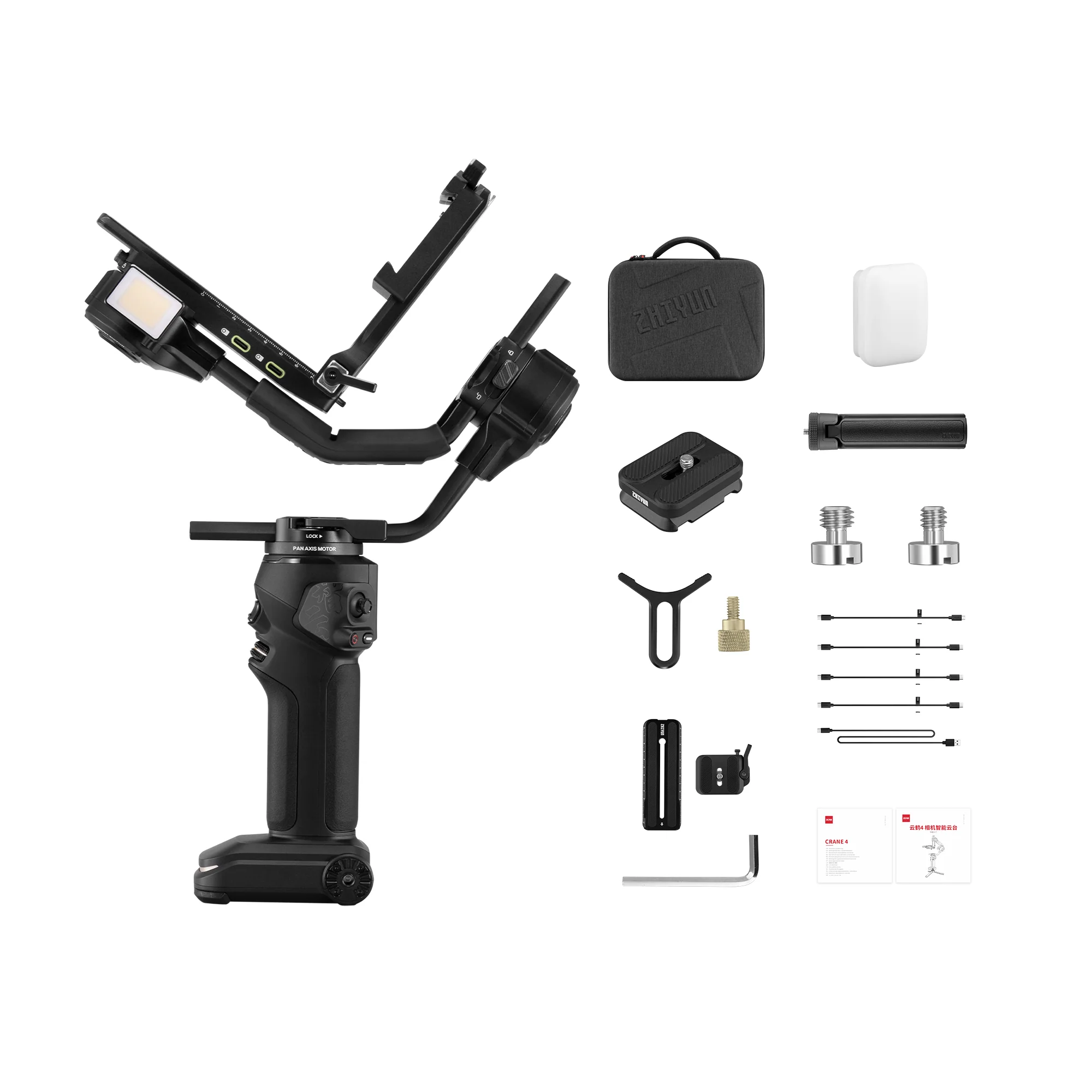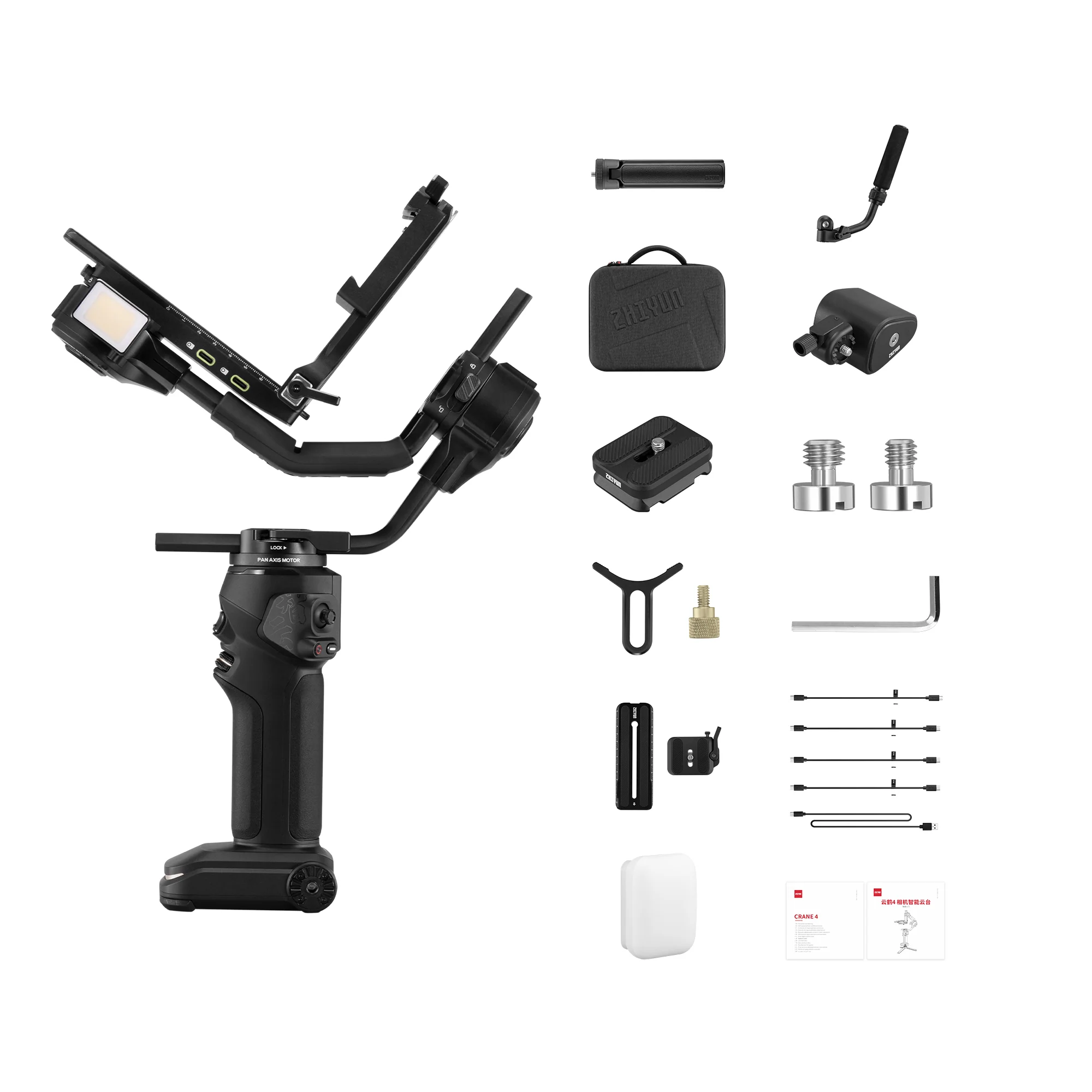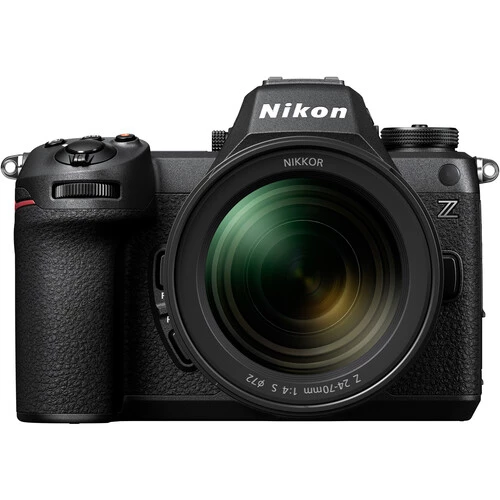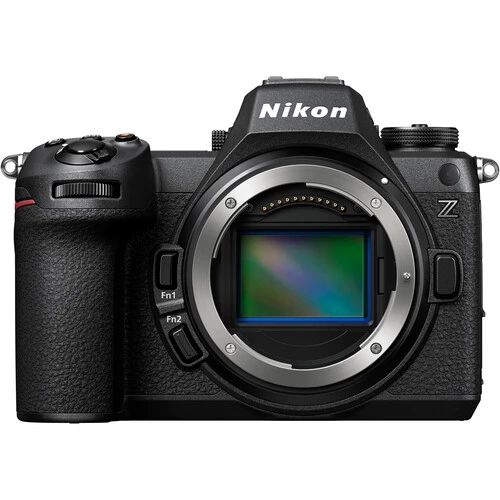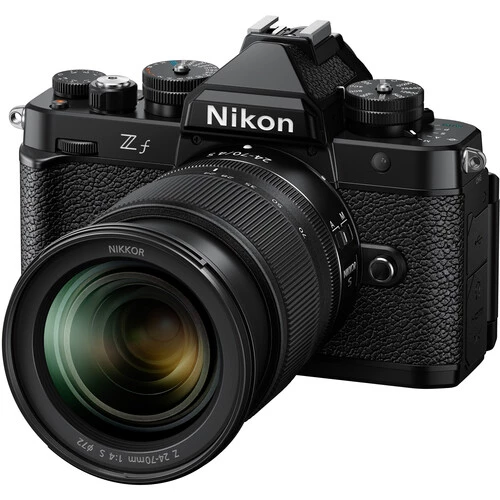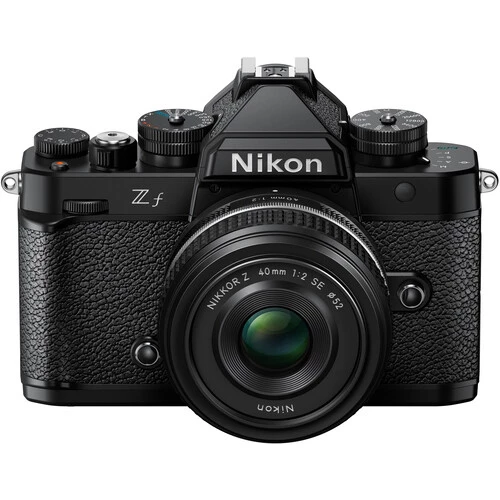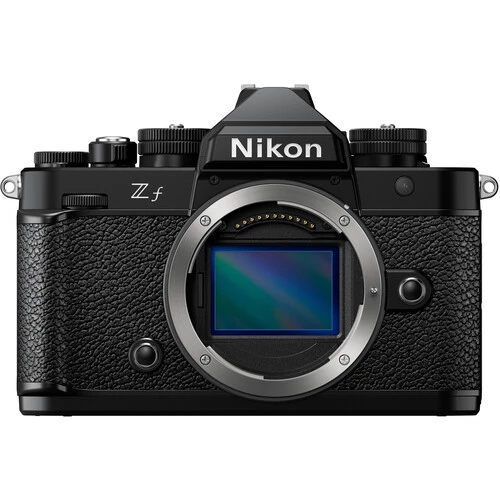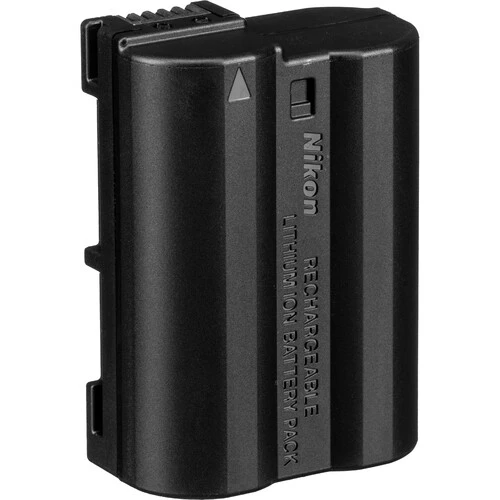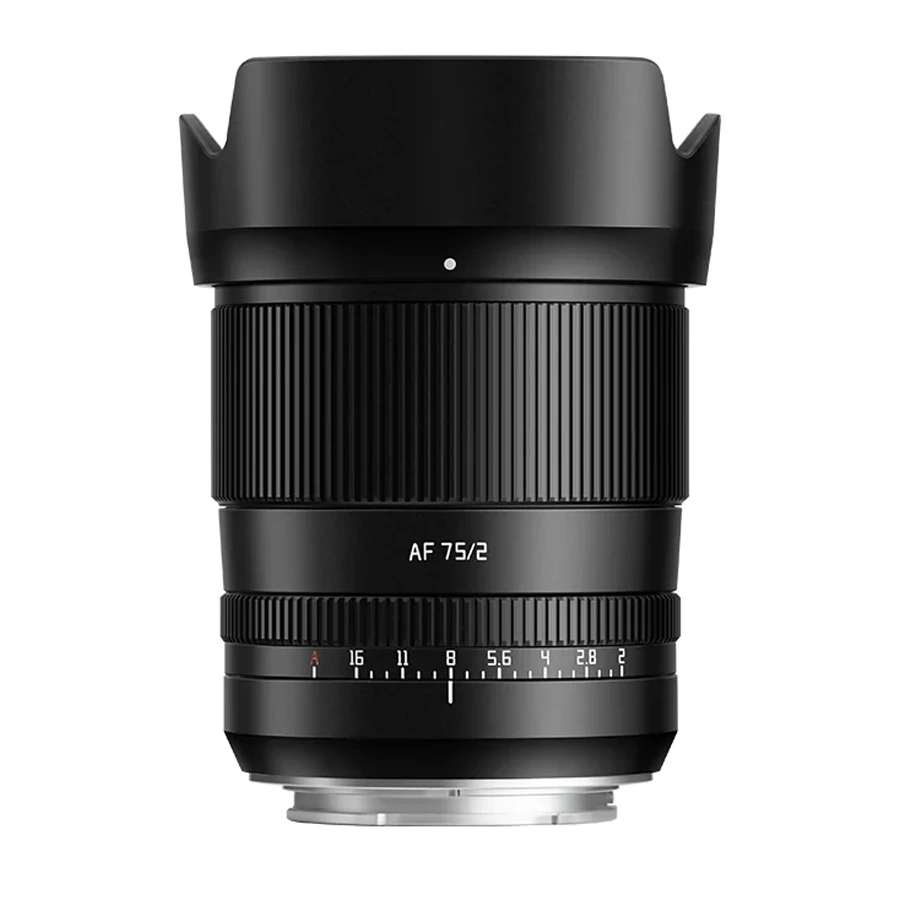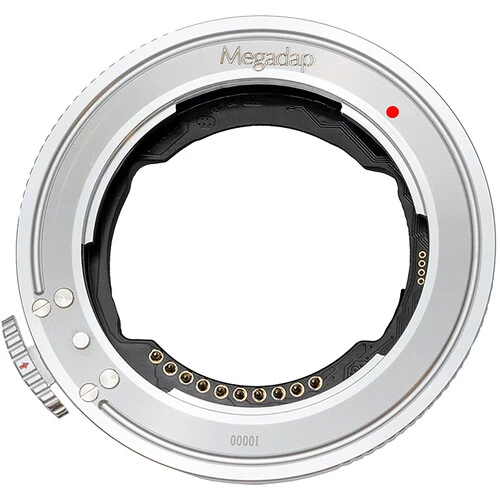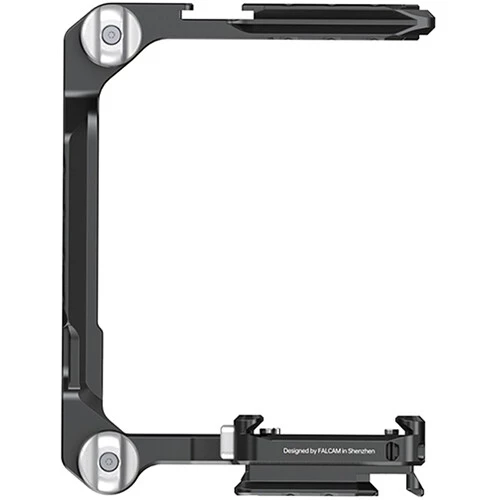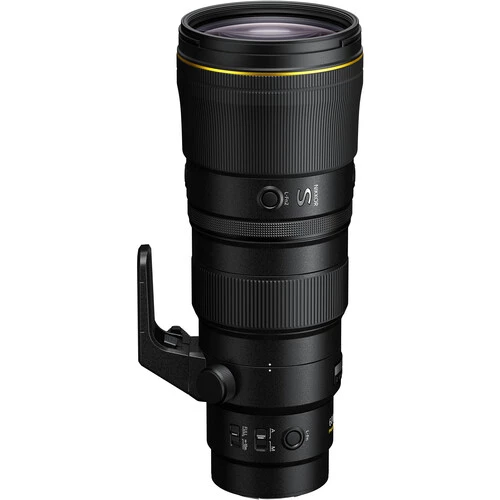Nikon Z8 Overview
Key Features
- 45.7MP FX-Format Stacked CMOS Sensor
- Lightweight Design, 30% Smaller than Z9
- 8.3K 60p N-RAW, 4.1K 60p ProRes RAW
- 8K30p and 4K120p Video, 10-Bit Internal
- Up to 20 fps Raw, 30 fps JPEG Shooting
- 493-Point AF, AI-Based Subject Detection
- Blackout-Free Real Live Viewfinder
- 3.2" 4-Axis Tilting Touchscreen LCD
- CFx Type B & SD Memory Card Slots
- 5 GHz Wi-Fi and Bluetooth
Compact, Lightweight, Powerful
Built using flagship DNA, the Nikon Z8 is a compact, lightweight camera housing much of the technology from the Z9 but in a sleeker, more portable package. Dubbed the ultimate hybrid camera, the Z8 features the same proven sensor, processing, and AF capabilities of the flagship with a new body design that better suits gimbal use, event shooting, and other handheld applications.
Flagship Sensor and Processing

45.7MP Stacked BSI CMOS Sensor
Featuring the same sensor that debuted in the Z9, the FX-format 45.7MP BSI stacked CMOS sensor offers a useful combination of resolution, fast readout speeds, impressive clarity, and minimal noise. The stacked design contributes to reduced rolling shutter while the BSI designation ensures improved noise levels when working at the top end of the extended ISO 32-102400 range. Also, the 45.7MP resolution and full-frame sensor size hit a sweet spot that benefits photographers working in detail-oriented genres as well as enables recording video at resolutions up to 8K.
EXPEED 7 Image Processor
Complementing the sensor is the EXPEED 7 processing engine, which offers speeds approximately 10x faster than a Z7 II. This engine works in conjunction with the stacked sensor design to realize impressively fast AF speeds, burst shooting rates, a high buffer capacity, fluid video performance, and quick all-around handling.
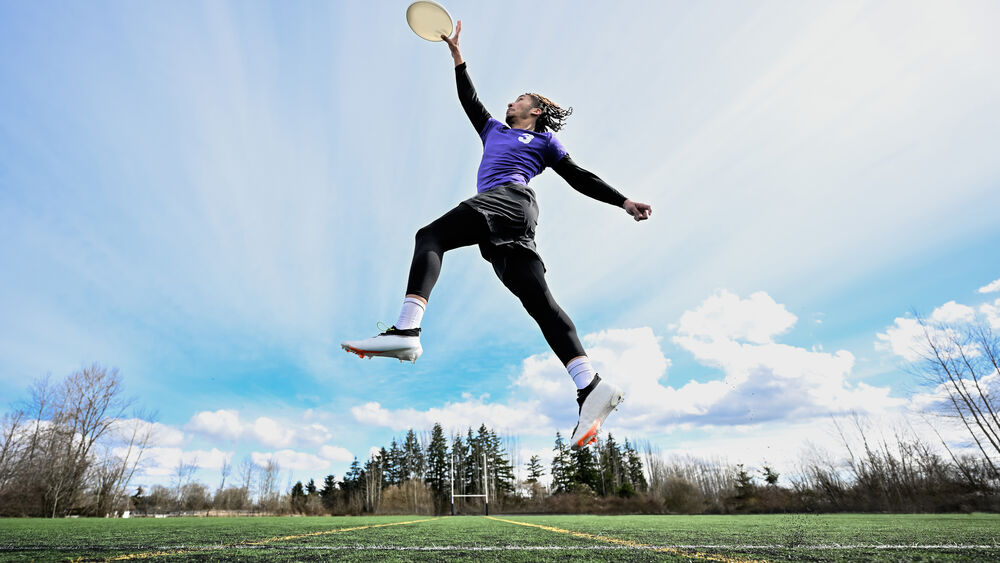
- Top continuous shooting speeds of 20 fps when shooting in raw, 30 fps when shooting in JPEG, 60 fps when shooting 19MP JPEGs using a DX area, and an impressive 120 fps shooting rate when recording 11MP stills, with all rates supporting full AF/AE performance.
- Able to buffer over 1000 raw images in a burst, meaning raw image sequences can be recorded for approximately 50 seconds continuously. Also, during playback, you can skip to the first shot of a given burst to expedite the on-camera review process.
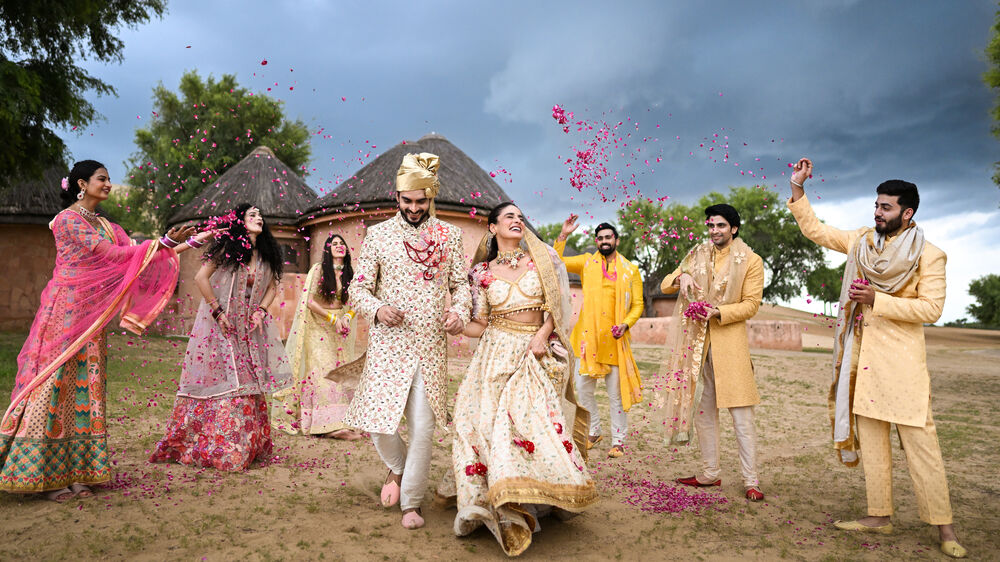
- Pre-Release Capture helps make decisive moment shots easier by recording frames in a burst for up a second prior to actually releasing the shutter. When this feature is activated, burst shooting will commence when the shutter is half-pressed and the buffer will retain up to a second's worth of frames prior to fully pressing the shutter.
- Electronic shutter affords a top shutter speed of 1/32,000 sec for working in the brightest conditions with wider apertures.
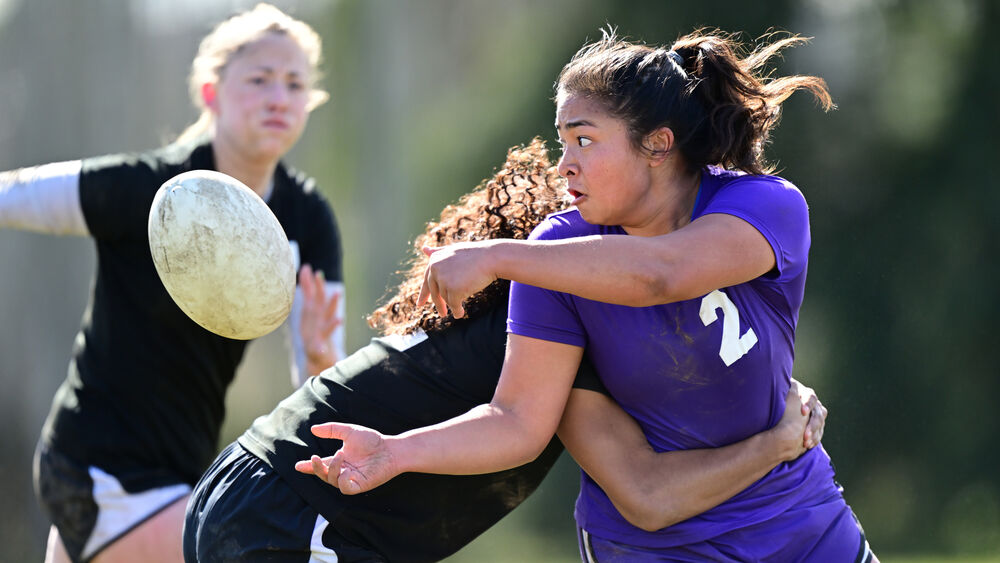
- Stacked sensor design reduces rolling shutter distortion so fast-moving subjects, like a golf club, tennis racket, or baseball bat, do not appear distorted when working with shutter speeds up to 1/32,000 sec.
- AF calculations are done at a 120 fps rate to keep up with fast continuous shooting speeds.
- High Efficiency RAW file format maintains image quality akin to uncompressed raw files but with file sizes approximately 30% smaller for faster reading/writing to the memory card.
- Stills can also be saved in the HEIF file format; a useful evolution from JPEG, this 10-bit format offers 1 billion more colors for greater realism and dynamic range when viewed on HLG-compatible displays while still retaining the small file size as a JPEG.
- Motion Blend Retouch feature can be used to produce an in-camera composite that depicts a series of subject movements within a single frame.
- Long Exposure display includes a live exposure timer on the rear LCD, along with the ability to dim the viewfinder to better preserve your night-adjusted vision.
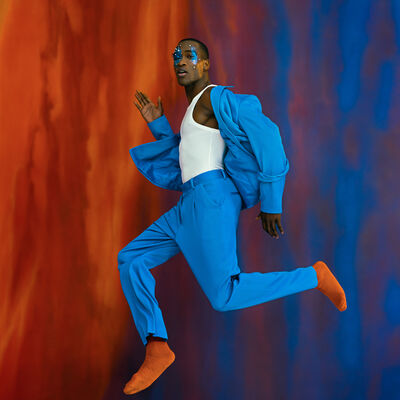
Electronic Shutter-Only Design
Relying on the speed and stacked design of the sensor, the Z8 completely forgoes a mechanical shutter and uses just an electronic shutter for all capture modes. The speed of the sensor enables recording at up to 1/32,000 sec and the stacked structure reduces motion distortion for accurate depiction of fast-moving subjects, like golf clubs, baseball bats, and automobiles. Also, despite the absence of a mechanical shutter, flash sync up to 1/200 sec. is still supported as well as high speed sync functions.
By removing the mechanical shutter, the Z8 can also operate completely silently and there is no worry over mechanical shutter wear or breakdown. A shutter release sound can be added for awareness when a photo is being taken, and the volume can be adjusted to suit different working scenarios.
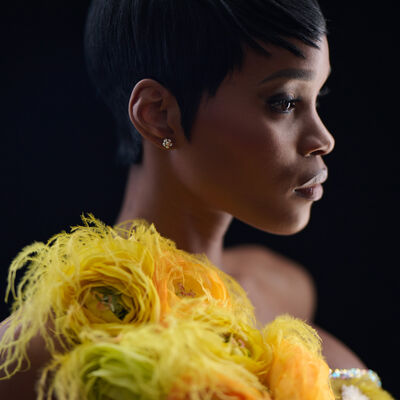
More Beautiful Portraits
Perfect for portraits, the Z8 improves on the sensor's inherent capabilities with a series of processing tools and shooting functions to improve portraits:
- Fine-tune hue and brightness while shooting for more precise control while shooting.
- Skin softening can be used on up to three subjects in a shot and slightly blurs the skin for a more pleasing texture while still retaining essential sharpness on eyes and hair.
- Manual white balance control is more intuitive when making adjustments and Auto WB has also been optimized for human subjects.
Fast and Intelligent AF
493-Point Phase-Detection AF
Covering the full sensor area, the Z8 uses the flagship 493-point phase-detection AF system to realize fast and accurate focusing performance. This system is benefitted by the high-speed communication of the Z interface along with the speed of the sensor that enables AF readings to occur at up to 120 fps.
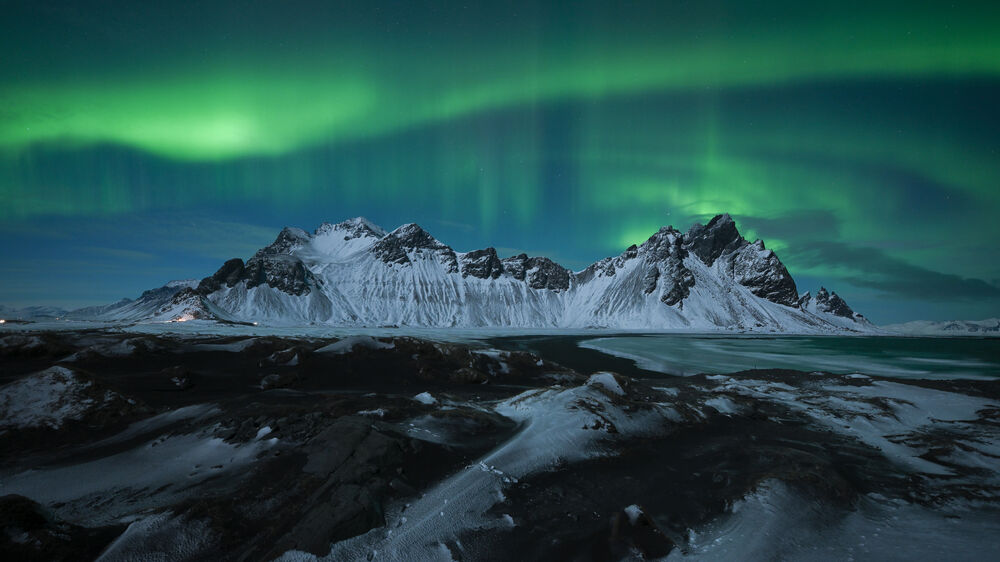
This focusing system also supports working in low-light conditions with a Starlight mode that permits focusing down to -9 EV to greatly benefit astrophotography, concert, and other nighttime shooting applications. Also useful for working in difficult lighting conditions, Backlit AF uses separate pixels on the sensor for AF, allowing these areas to intentionally overexpose for focusing accuracy purposes without impacting the actual exposure of the recorded image.
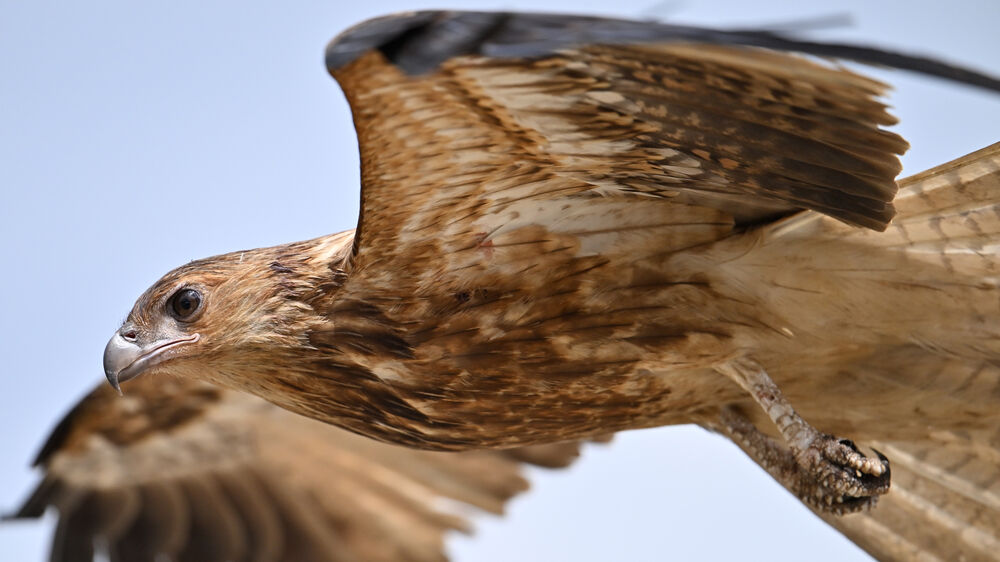
A mainstay focusing mode in DSLRs, which debuted for mirrorless with the Z9, the Z8 also includes 3D Tracking AF that pairs with subject detection to lock onto fast, erratically moving subjects that move parallel and perpendicular to the camera. Additionally, there are three Dynamic-Area AF modes, with a range of focus area sizes, for capturing a broad variety of moving subject types.
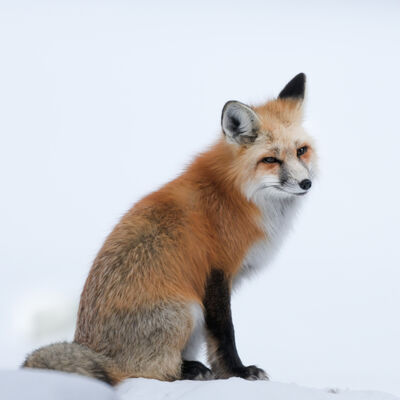
Subject Detection with Deep Learning Technology
Utilizing inherited algorithms and deep learning technology from the Z9, including sophisticated Subject Detection, the Z8 can recognize a variety of distinct subject types, ranging from humans to animals to airplanes to bicycles. When working in Auto-Area AF, these subjects will automatically be detected, focused on, and tracked to ensure sharp focus when the subject is moving across the frame.
Eye-Detection AF, specifically, has been tuned for improved accuracy and refined recognition of eyes in the scene, regardless of how small or large they are within the image frame, and can also be used in conjunction with custom Wide-Area AF for different subject shapes and sizes.
Video Powerhouse
Internal 8K60 and 4K 120 Recording
Equally capable for video, the Z8 matches the Z9's recording capabilities here, as well, with a variety of resolutions and frame rates available up to 8K. Using full pixel readout, UHD 8K 30p video can be recorded with continuous shooting possible for approximately 2 hours 5 minutes.
UHD 4K and Full HD recording is also possible in a variety of frame rates, including full-frame 4K recording at up to 120p for slow-motion playback. Using an 8K area, oversampled UHD 4K recording is possible at up to 60p for increased sharpness and detail. Also, high-resolution frame grabs can be recorded in camera from 8K and 4K videos, for producing 33MP or 11MP stills, respectively.
12-Bit N-RAW and ProRes RAW Video
Internal 12-bit raw recording at up to 8.3K 60p in the N-RAW format is supported along with internal ProRES RAW HQ. Raw recording offers greater tonal and color latitude and can improve dynamic range, benefitting color grading needs and post-production flexibility.
- N-RAW is Nikon's own raw recording format that offers impressively small file sizes compared to other raw formats as well as the ability to create MP4 proxies for more efficient previewing or transferring.
- N-RAW recording is available at up to 8.3K at 60p or 24p; 4.1K at up to 120p; 5.3K at up to 60p with a 1.5x crop; and 3.8K at 120p with a 2.3x crop.
- ProRes RAW recording is also available at up to 4.1K and 60p.
ProRes and H.265 10-Bit Recording
Internal recording is also supported with 10-bit color and 4:2:2 sampling in the ProRes 422 HQ and H.265 codecs, and H.264 and 4:2:0 color can be used depending on workflow needs. For more latitude when color grading in post, there is also a 10-bit N-Log setting as well as a Flat color profile. Additionally, HLG (Hybrid Log Gamma) can be used for creating HDR-ready content straight from the camera.
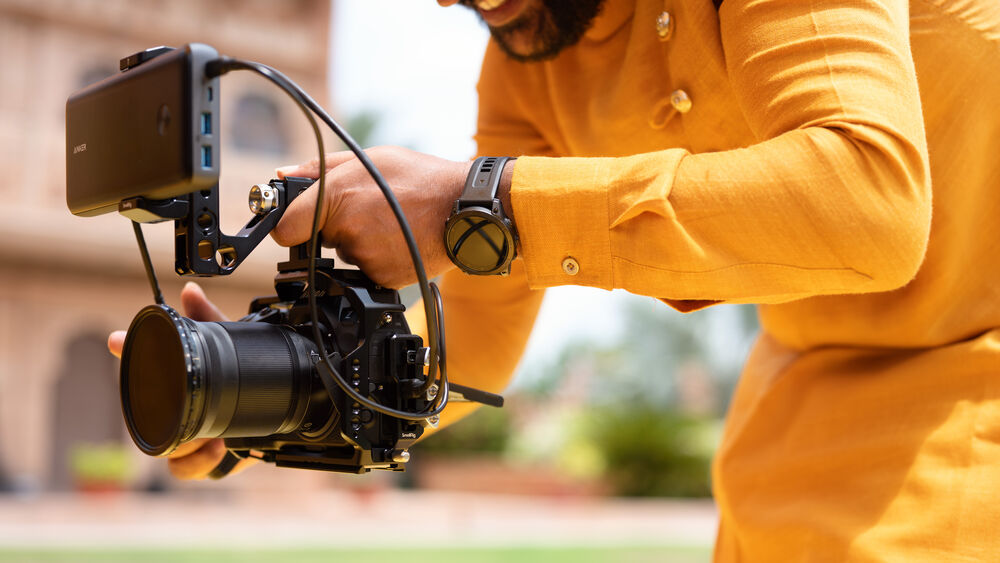
Recording Support
Aiding the impressive recording specs, the Z8 also incorporates a variety of useful recording tools and functions for use in productions:
- Red REC frame indicator on EVF and LCD during recording to easily recognize when recording is being captured.
- Dedicated video info display indicates various recording settings, such as frame size, frame rate, audio settings, codec, bit depth, and HDMI output settings. Some of these settings will also be visible on the camera's top control panel.
- Focus peaking and zebra stripes are visual aids to help achieve sharp focus and accurate exposure.
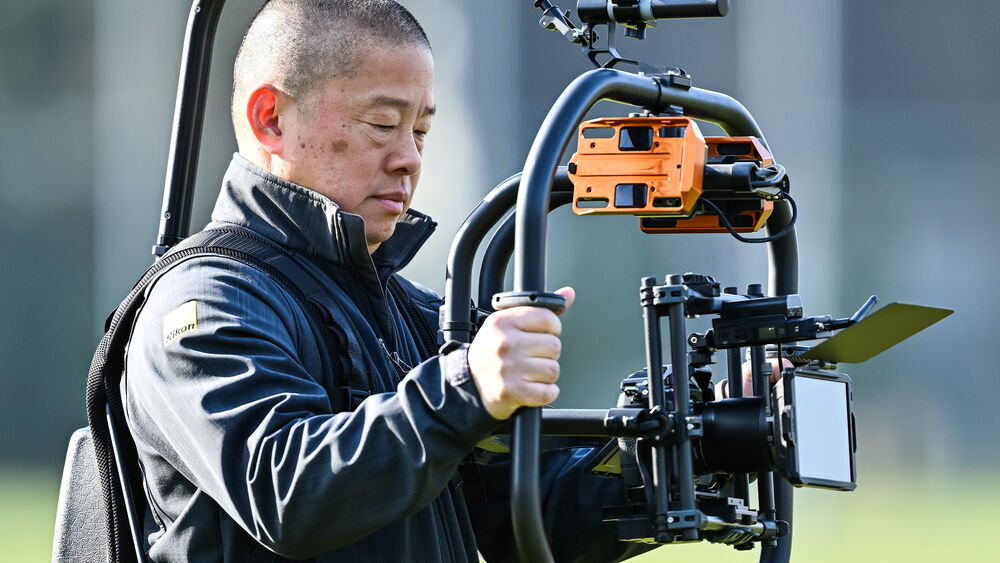
- Waveform monitor for realtime exposure analysis.
- Fine ISO control in Manual mode for adjusting exposure in 1/6-stop increments.
- Fast AF-ON function can be assigned to Fn buttons; it is now possible to assign two different AF speeds to different buttons.
- Slow shutter speed video is supported, slower than 1/frame rate, for working in extreme low-light conditions or for creating intentionally blurred effects.
- Timecode linking is possible when working with an optional timecode generator.
- Complementing the video capabilities, the Z8 also supports 24-bit linear PCM sound recording and offers compatibility with external XLR microphones via the optional Tascam CA-XLR2d-AN digital adapter.
A Smaller Professional Body Design
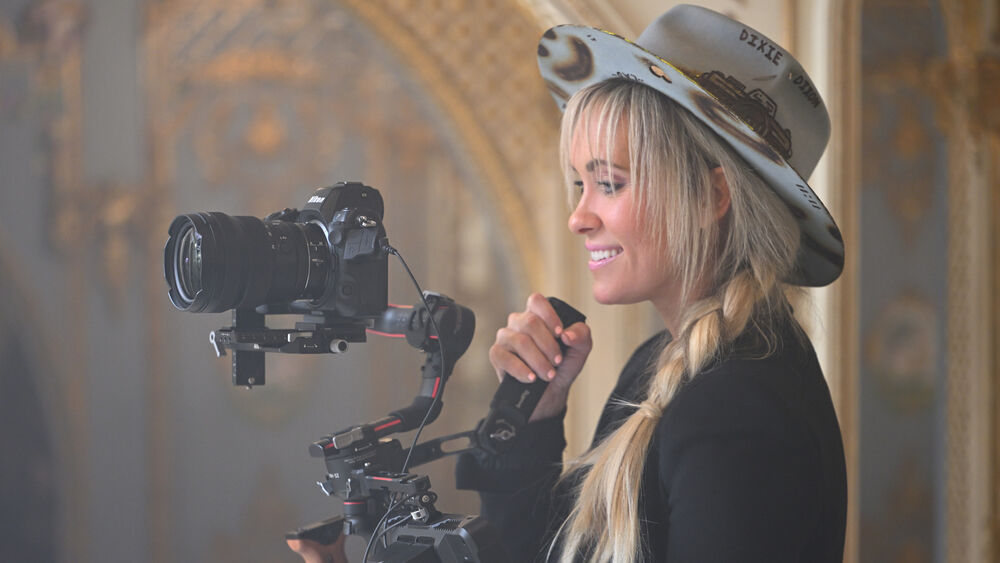
Sleek, Modular, and Durable Construction
- Deemed the true successor to the D850 DSLR and the smaller follow-up to the flagship Z9, the Z8 hits a sweet spot in terms of size and performance. It is 30% smaller than the Z9 and 15% smaller than the D850.
- Compared to the Z9, with its built-in vertical grip, the Z8 takes on a more modular design, allowing you to keep it small for day-to-day shooting or pair it with the optional MB-N12 Power Battery Pack grip for improved ergonomics when shooting vertical and better battery life. Also, the smaller, lighter design makes the Z8 an ideal candidate for rigging or use on a gimbal for video use.
- Dual card slots—one CFexpress Type B slot and one UHS-II SD slot—allow for flexible file saving. The CFx slot is suitable for data-intensive applications, like 8K recording and high-speed burst shooting, while the SD slot retains compatibility with the popular storage format. Additionally, the CFx B slot is also compatible with XQD memory cards.
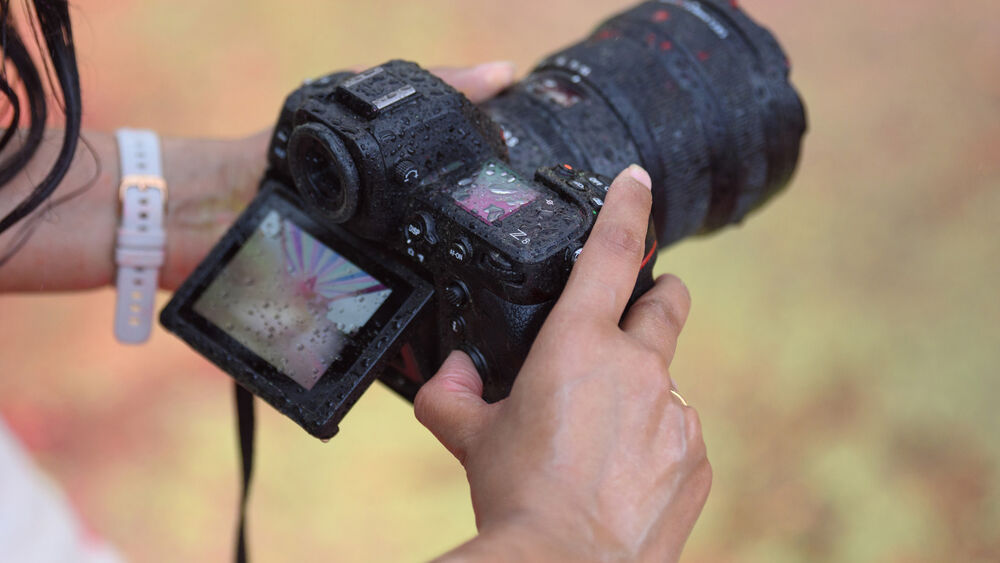
- Built using eco-friendly Seerebo carbon fiber and robust magnesium alloy, the Z8 manages to be both durable and lightweight, weighing just 2 lb.
- Premium weather sealing protects against dust and moisture for confident use in harsh climates.
- Included EN-EL15c battery offers approximately 340 frames per charge when primarily using the viewfinder or 370 shots per charge when primarily using the LCD monitor. The Z8 is also compatible with other EN-EL15-series batteries.
- In-body Vibration Reduction now supports Synchro VR to achieve up to 6 stops of camera shake compensation when used with select Z lenses.
- Helping to cut down on dust reaching the sensor, the Z8 incorporates a sensor shield that protects the sensor surface when changing lenses. For additional dust prevention, there is also a dual electro-conductive and fluorine coating on the optical filter covering the sensor.
- Backlit buttons offer easier navigation and button recognition when working in low-light conditions.
Real-Live Viewfinder
- Real-Live Viewfinder is an advanced EVF utilizing a 3.69m-dot OLED panel with adjustable luminance up to 3000 cd/m2 for clear visibility in bright conditions. This EVF also works in conjunction with dual-stream technology for blackout-free viewing when shooting continuously and it features a high fps function, which ups the EVF's refresh rate to 120 fps for smoother, lifelike viewing.
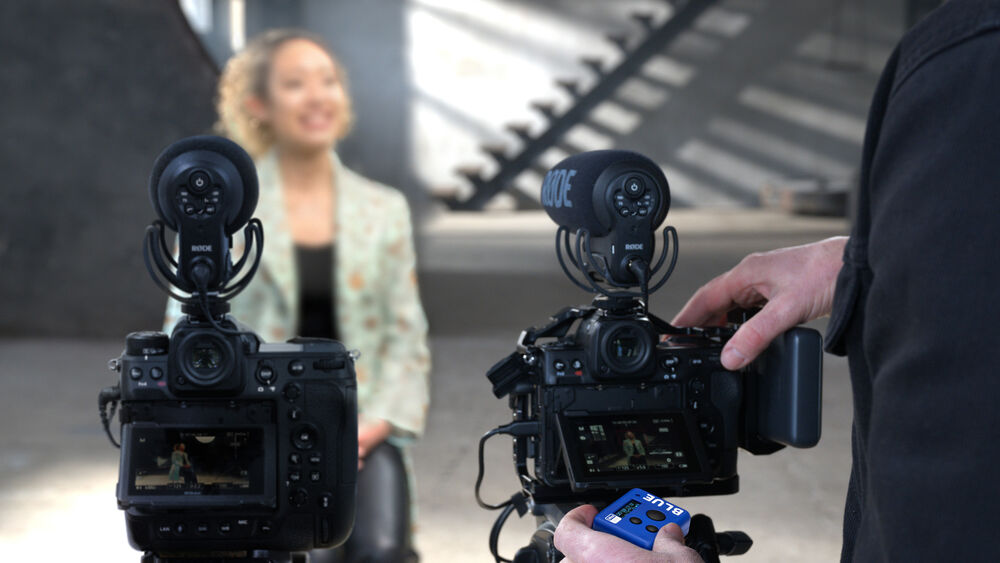
Four-Axis Tilting LCD
- Like the Z9, the Z8 incorporates a unique 3.2" 2.1m-dot four-axis tilting touchscreen LCD that better supports working from high and low angles, regardless if shooting in the horizontal or vertical orientation. This screen's four-way tilting design allows for easier viewing from a variety of positions and the user interface orientation will also shift depending on how the camera is held.
Versatile Connectivity
Matching the professional build quality, the Z8 is fitted with a variety of connectivity options to suit various workflow needs:
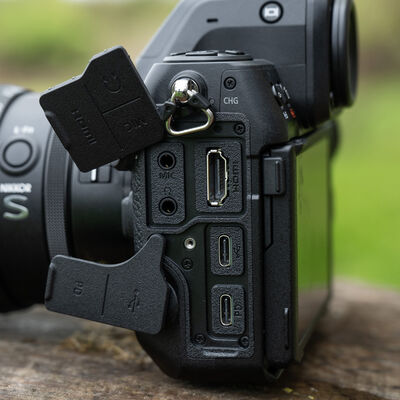
- Full-size HDMI port for outputting video to an external recorder or monitor
- 3.5mm headphone and microphone ports for attaching an external microphone and for on-board audio monitoring
- Two USB-C ports: one supports file transfers and tethering and the second is dedicated to power delivery and battery charging
- USB-C communication terminal supports USB-LAN connectivity when paired with an optional USB-C to Ethernet adapter. This enables a 1000BASE-T wired LAN connection for transferring files over FTP
- 10-pin port offers wide accessories and remote connectivity
- Bluetooth and Wi-Fi (2.4 and 5 GHz) permit wireless transferring of files, remote camera control via a mobile device, and works in conjunction with the NX Mobile Air app for file management

Falcam C00B3903 Overview
Key Features
- Maintains Access to Controls & Ports
- Multiple 1/4"-20 & 3/8"-16 ARRI Threads
- Quick Release Mounting, Cold Shoe Mount
- Durable Aluminum Construction
Outfit your compatible Nikon Z8 camera with an ergonomic aluminum alloy cage using the Quick Release Camera Cage from Falcam. Its custom-fit design maintains access to your camera's controls and ports. Multiple 1/4"-20 and 3/8"-16 ARRI-style threads allow you to mount articulating arms and secondary monitors on your rig. Its design also allows you to orient the camera in portrait or landscape mode.
A top shoe mount lets you attach a shotgun microphone or fill light, but it doesn't block the camera's hot shoe for adding powered accessories. This cage is compatible with Falcam F22, F38, and F50 quick release accessories for single-button integration of additional arms and adapters to increase your mounting options.
Compatibility
Nikon Z8 mirrorless camera
Falcam F22&F38&F50 Quick Release Foldable Half Cage Kit C00B3809
Key Features
- Two Rotating Shaft Designs
- Compatible with F22, F38 and F50 Quick Release System
- 1/4"-20 Threaded Holes
- ARRI Locating Holes &Strap Holes
- Wire Clamp Locating Holes
- Anti-mistouch & Anti-deflection Design
- Ultra-portable Foldable Design
- Half Cage's Flat State (maximum lever) Can Bear 4.5kg
- Fit Multiple Camera Models
Overview
The Falcam Foldable Half Camera Cage offers a versatile solution for various shooting scenarios. It features a unique dual-axis design that allows you to adjust the angles of the top, side, and bottom plates with ease, transforming it from a full cage into a half-cage configuration. The half-cage's bottom plate is equipped with an F38 quick-release interface, enabling effortless camera assembly and disassembly.
This cage is compatible with the F22, F38, and F50 quick-release systems, offering a range of attachment options such as 1/4" threaded holes, ARRI locating holes, wire clamp locating holes, strap holes, and cold shoe mounts to meet diverse expansion needs. It features a double-locking mechanism for enhanced stability, ensuring your camera stays securely in place.
The Falcam Foldable Half Camera Cage is compatible with a wide range of cameras, including Sony, Canon (R5/R6/R7/R10), Nikon (Z5/Z50/Z6/Z60/Z7), Fuji (XT series, XH series), and more. For certain blocky camera models like the Nikon Z8/Z9, the cage offers a unique vertical top plate installation method, similar to an L bracket.
With the option to pair it with Falcam F22, F38, F50, or Maglink quick release accessories, you'll experience seamless and fast transitions between different photography scenarios. Don't miss the opportunity to make your photography more versatile and efficient with the Falcam Foldable Half Camera Cage.
Camera Compatibility List
- Sony: A7 IV, A7R V, A7S III, A7 III, A7R IVa, A7R IIIa, A7C, A7C2, A6700, A6600, A6400, A6100, ZV-E1, ZVE-10, ZV1, FX3, FX30
- Fujifilm: X-T1, X-T2, X-T3, X-T4, X-T5, X-T20, X-T30, X-S10, X-S20, H1, X-H2S
- Lumix: S5, S5MK2, S5M2X, G9, DH6A, GH6L, G95D, G7, G100K
- Canon: R5, R6, R6MK2, R7, R8, R10
- Nikon: ZFC, Z30, Z5, Z50, Z6, Z60, Z7
- Sigma: FP, FPL
- Olympus: E-M10, OM-5, OM-1
Zhiyun Crane 4 Overview
Key Features
- 13.2 lb Load Capacity
- Extended Arm for Full-Frame Lenses
- Dual-Layer Quick Release Plates
- 360° Pan, 207° Tilt, 70° Roll Rotation
- Bluetooth 5.0 Shutter Control
- Built-In 3200 Lux Fill Light
- Adjustable Color Temperature
- Creative Operation Modes, 12-Hr Runtime
- 1.22" Touchscreen, Balance Indicators
- 2600mAh Batteries, PD Fast Charge
The Zhiyun CRANE 4 takes the familiar form factor and lightweight experience of previous Zhiyun gimbals while expanding the onboard features for native portrait shooting, Bluetooth shutter control, and an extended grip to accommodate cameras with full-frame lenses. Control the 360° pan, 207° tilt, and 70° roll rotation using the onboard controls. Balance indicator lights on each motor aid in achieving precise calibration. Dual-layer quick release plates facilitate both landscape and portrait-oriented shooting with ease. Easily control your settings with the 1.22" color touchscreen and Bluetooth-powered wireless shutter. The CRANE 4 also features a built-in fill light with a 3200 lux output and adjustable color temperature.
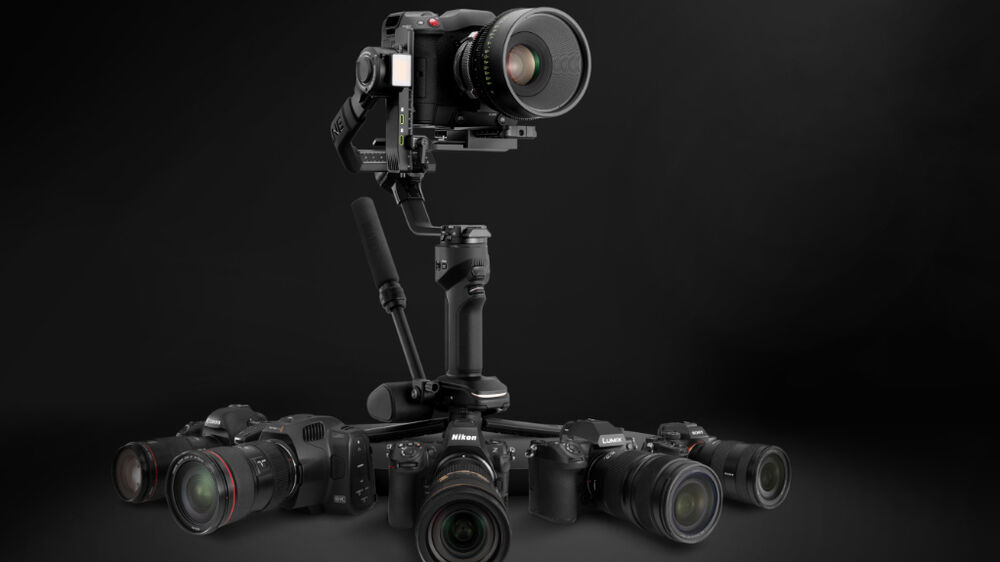
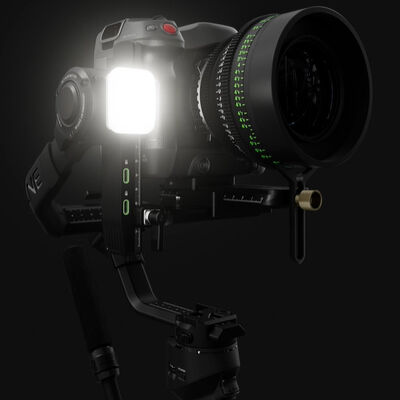
Lightweight Design, Extended Arm Length
- With the CRANE 4 redesign comes an extended arm length and stronger motors, which expands the gimbal's gimbal and lens compatibility to DSLR, mirrorless, and compact cinema cameras with full-frame lenses attached.
- The gimbal weighs just 3.6 lb but has a 13.2 lb load capacity capable of supporting cameras like the Canon EOS 5D Mark IV, Blackmagic Pocket Cinema Camera 6K Pro, Nikon Z8, Panasonic LUMIX S1H, and Sony a7S III, all with full-frame lenses attached.
- For a full list of compatible cameras, please see the most current compatibility information on the Zhiyun website page or see the camera compatibility list in PDF format.
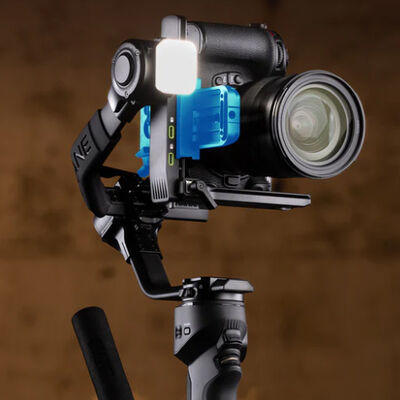
Dual-Layer Quick Release, Lens Support
Mount your camera of choice on the camera quick release plate or upper quick release plate for efficient integration and balancing with the dual-layer plates on the CRANE 4. The lower quick release plate slides in the landscape orientation baseplate and offers a mounting point for the included lens support when using heftier full-frame lenses. The upper quick release slides easily into the portrait orientation baseplate.
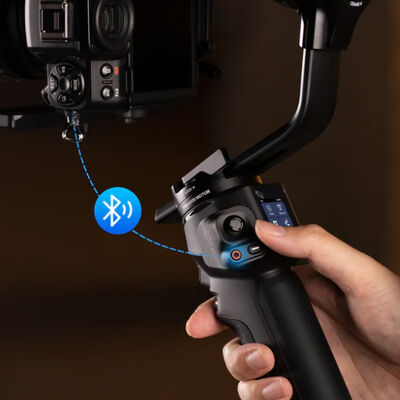
Bluetooth 5.0 Shutter Control
While the included camera control cables offer the option for wired shutter control, avoid complicated cable runs by using the embedded Bluetooth 5.0 shutter control. Wirelessly control your compatible camera's shutter and toggle recording via the onboard controls and touchscreen. For a full list of Bluetooth-compatible cameras, please see the most current compatibility information on the Zhiyun website page or see the camera compatibility list in PDF format.
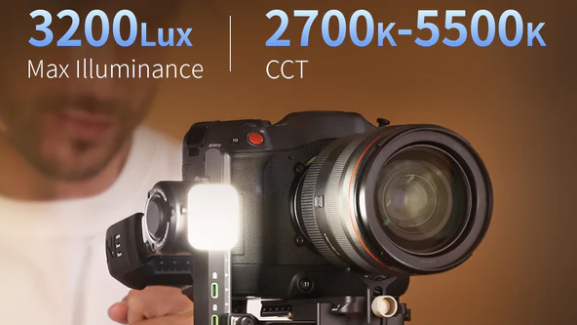
Powerful, Bright Fill Light
- A built-in 10W fill light easily lights subjects thanks to its 3200 lux brightness. An included fill light diffuser can soften the light's effect as needed.
- The light has a CRI of 95+ for accurate and natural color reproduction.
- Adjust the color temperature of the light from 2700 to 5500K with the onboard control wheel.
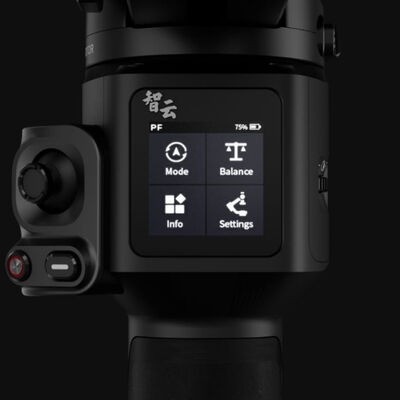
1.22" Color Touchscreen, Onboard Controls
- Toggle between gimbal modes like Pan Follow Mode, Lock Mode, POV Mode, Follow Mode, Go Mode, Vortex Mode, and Portrait Mode.
- Other shooting features include Panorama, Timelapse, and Motionlapse.
- Check and view the balance status of each axis in real time.
- Auto-calibrate after your rig is fully balanced.
- Set the motor torque, smoothness, follow speed, and joystick speed of the gimbal.
- Customize the function of the trigger button and front dial to toggle settings or modes of your choice.
ZY Play App
Control your gimbal remotely from your iOS or Android device using the ZY Play App. Features of the app include virtual joystick control, photo and video control, motion sensor control, timelapse, panorama, and firmware upgrade. The gimbal's embedded Bluetooth technology facilitates the app connection.
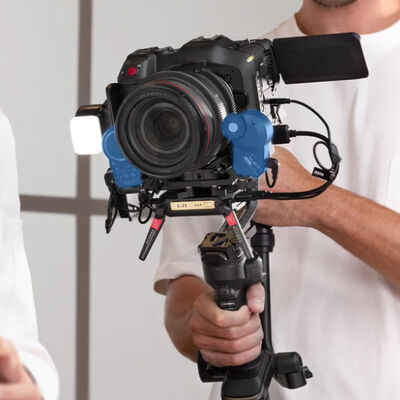
Follow Focus and Video Transmitter Integration
Attach additional pro-level tools to the CRANE 4 to communicate to others on set. Two USB-C ports at the front of the camera mounting area can connect follow focus motors for remote camera control. Another USB-C port at the back of the camera accepts the included camera control cables or connects to the separately available TransMount Image Transmission system. The transmitter unit can mount onto the bottom of your gimbal's baseplate to communicate with its corresponding viewing monitor.

All-Day Production
Four built-in 18650 batteries with a 2600mAh total capacity offer a runtime of 12 hours to shoot all-day events. The USB-C charging port supports PD fast charging to get you back up and running in 1.5 hours. You can charge the gimbal while it's in use to keep capturing the action.
Zhiyun Crane 4 Overview
Key Features
- 13.2 lb Load Capacity
- Extended Arm for Full-Frame Lenses
- Dual-Layer Quick Release Plates
- Sling Grip, Wrist Rest
- 360° Pan, 207° Tilt, 70° Roll Rotation
- Bluetooth 5.0 Shutter Control
- Built-In 3200 Lux Fill Light
- Creative Operation Modes, 12-Hr Runtime
- 1.22" Touchscreen, Balance Indicators
- 2600mAh Batteries, PD Fast Charge
The Zhiyun CRANE 4 takes the familiar form factor and lightweight experience of previous Zhiyun gimbals while expanding the onboard features for native portrait shooting, Bluetooth shutter control, and an extended grip to accommodate cameras with full-frame lenses. This combo kit version outfits you with a sling grip and wrist rest for an improved low-angle shooting experience. Control the 360° pan, 207° tilt, and 70° roll rotation using the onboard controls. Balance indicator lights on each motor aid in achieving precise calibration. Dual-layer quick release plates facilitate both landscape and portrait-oriented shooting with ease. Easily control your settings with the 1.22" color touchscreen and Bluetooth-powered wireless shutter. The CRANE 4 also features a built-in fill light with a 3200 lux output and adjustable color temperature.


Lightweight Design, Extended Arm Length
- With the CRANE 4 redesign comes an extended arm length and stronger motors, which expands the gimbal's gimbal and lens compatibility to DSLR, mirrorless, and compact cinema cameras with full-frame lenses attached.
- The gimbal weighs just 3.6 lb but has a 13.2 lb load capacity capable of supporting cameras like the Canon EOS 5D Mark IV, Blackmagic Pocket Cinema Camera 6K Pro, Nikon Z8, Panasonic LUMIX S1H, and Sony a7S III, all with full-frame lenses attached.
- For a full list of compatible cameras, please see the most current compatibility information on the Zhiyun website page or see the camera compatibility list in PDF format.

Dual-Layer Quick Release, Lens Support
Mount your camera of choice on the camera quick release plate or upper quick release plate for efficient integration and balancing with the dual-layer plates on the CRANE 4. The lower quick release plate slides in the landscape orientation baseplate and offers a mounting point for the included lens support when using heftier full-frame lenses. The upper quick release slides easily into the portrait orientation baseplate.

Bluetooth 5.0 Shutter Control
While the included camera control cables offer the option for wired shutter control, avoid complicated cable runs by using the embedded Bluetooth 5.0 shutter control. Wirelessly control your compatible camera's shutter and toggle recording via the onboard controls and touchscreen. For a full list of Bluetooth-compatible cameras, please see the most current compatibility information on the Zhiyun website page or see the camera compatibility list in PDF format.

Powerful, Bright Fill Light
- A built-in 10W fill light easily lights subjects thanks to its 3200 lux brightness. An included fill light diffuser can soften the light's effect as needed.
- The light has a CRI of 95+ for accurate and natural color reproduction.
- Adjust the color temperature of the light from 2700 to 5500K with the onboard control wheel.

1.22" Color Touchscreen, Onboard Controls
- Toggle between gimbal modes like Pan Follow Mode, Lock Mode, POV Mode, Follow Mode, Go Mode, Vortex Mode, and Portrait Mode.
- Other shooting features include Panorama, Timelapse, and Motionlapse.
- Check and view the balance status of each axis in real time.
- Auto-calibrate after your rig is fully balanced.
- Set the motor torque, smoothness, follow speed, and joystick speed of the gimbal.
- Customize the function of the trigger button and front dial to toggle settings or modes of your choice.
ZY Play App
Control your gimbal remotely from your iOS or Android device using the ZY Play App. Features of the app include virtual joystick control, photo and video control, motion sensor control, timelapse, panorama, and firmware upgrade. The gimbal's embedded Bluetooth technology facilitates the app connection.

Follow Focus and Video Transmitter Integration
Attach additional pro-level tools to the CRANE 4 to communicate to others on set. Two USB-C ports at the front of the camera mounting area can connect follow focus motors for remote camera control. Another USB-C port at the back of the camera accepts the included camera control cables or connects to the separately available TransMount Image Transmission system. The transmitter unit can mount onto the bottom of your gimbal's baseplate to communicate with its corresponding viewing monitor.

All-Day Production
Four built-in 18650 batteries with a 2600mAh total capacity offer a runtime of 12 hours to shoot all-day events. The USB-C charging port supports PD fast charging to get you back up and running in 1.5 hours. You can charge the gimbal while it's in use to keep capturing the action.
Nikon Z6 III Overview
Key Features
- 24.5MP Partially-Stacked CMOS Sensor
- EXPEED 7 Image Processor
- 6K 60p N-RAW, 6K 30p ProRes RAW
- 4K 120p, Full HD 240p Slow Motion Video
- Up to 20 fps Raw, 60 fps JPEG Shooting
- Blackout-Free, 5760k-Dot EVF
- 493-Point AF, AI-Based Subject Detection
- 3.2" 4-Axis Tilting Touchscreen LCD
- CFx Type B & SD Memory Card Slots
- NIKKOR Z 24-120mm f4 S Lens
Sporting a new and inspired partially-stacked sensor design, the Nikon Z6 III Mirrorless Camera unlocks a number of flagship-level upgrades for this mid-range camera, including faster and more precise autofocus, professional-level 6K internal raw video, pre-capture at up to 120 fps, and a smooth, bright, colorful EVF. Taken together, these upgrades make this mirrorless monster an ideal choice for aspiring professionals in search of an all-around, affordable camera.
Newly Designed Sensor and Flagship Processing
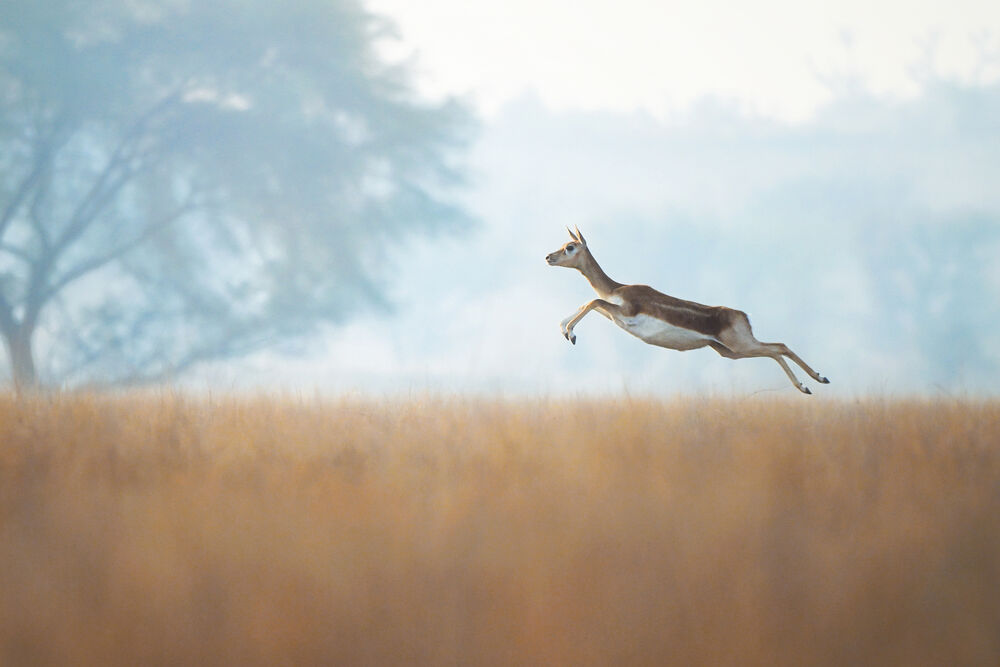
24.5MP Partially-Stacked CMOS Sensor
The Z6 III is Nikon's first camera to to feature a partially stacked sensor design for faster scans and readouts than its predecessor, as well as reducing rolling shutter. Additionally, this sensor design unlocks many of the flagship-level features in the camera, like faster autofocus, a smoother EVF experience, faster continuous shooting speeds, and higher frame rates when shooting video.
EXPEED 7 Image Processor
Complementing the sensor is the EXPEED 7 processing engine, found in the top-of-the-line Z8 and Z9 mirrorless cameras an which offers speeds approximately 10x faster than the Z6II. This engine works in conjunction with the partially-stacked sensor design to realize impressively fast AF speeds, burst shooting rates, a high buffer capacity, fluid video performance, and quick all-around handling.

- Top continuous shooting speeds of 20 fps when shooting in raw, up to 60 fps when shooting in full-frame JPEG, and 120 fps when shooting JPEGs using a DX crop, with all rates supporting full AF/AE performance.
- Able to buffer over 1000 images in a burst when using the electronic shutter, meaning image sequences can be recorded for approximately 50 seconds continuously.
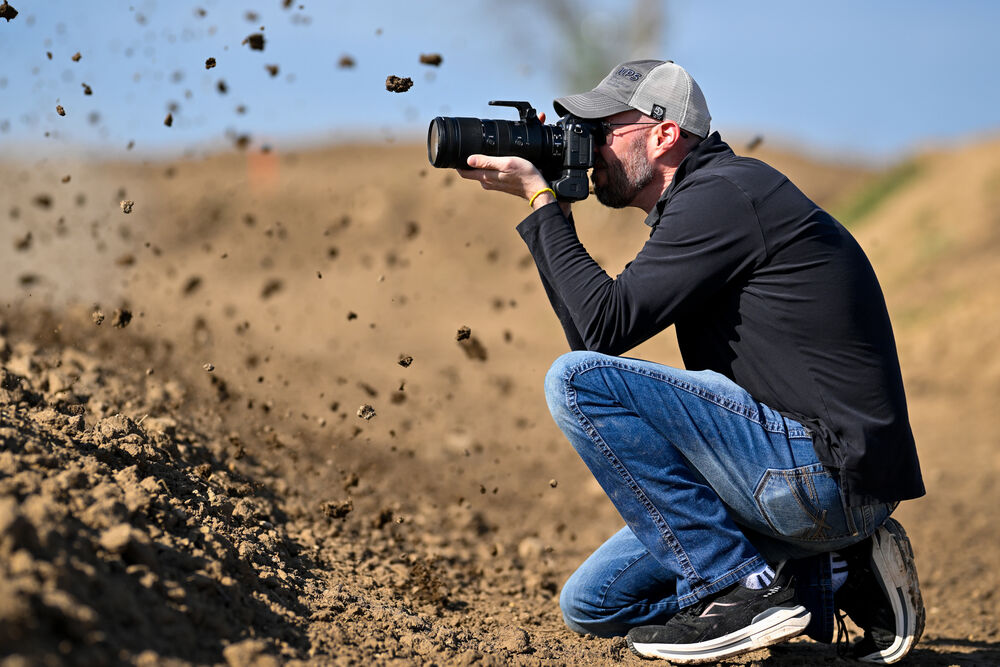
- Pre-Release Capture at up to 120 fps helps make decisive moment shots easier by recording frames in a burst for up to a second prior to actually releasing the shutter. When this feature is activated, burst shooting will commence when the shutter is half-pressed and the buffer will retain up to 4 seconds' worth of frames after fully pressing the shutter.
- Electronic shutter affords a top shutter speed of 1/16,000 sec for working in the brightest conditions with wider apertures.
- Partially-stacked sensor design reduces rolling shutter distortion so fast-moving subjects, like a golf club, tennis racket, or baseball bat, do not appear distorted when working with shutter speeds up to 1/16,000 sec.
- AF calculations are done at a 120 fps rate to keep up with fast continuous shooting speeds.
Fast and Intelligent AF
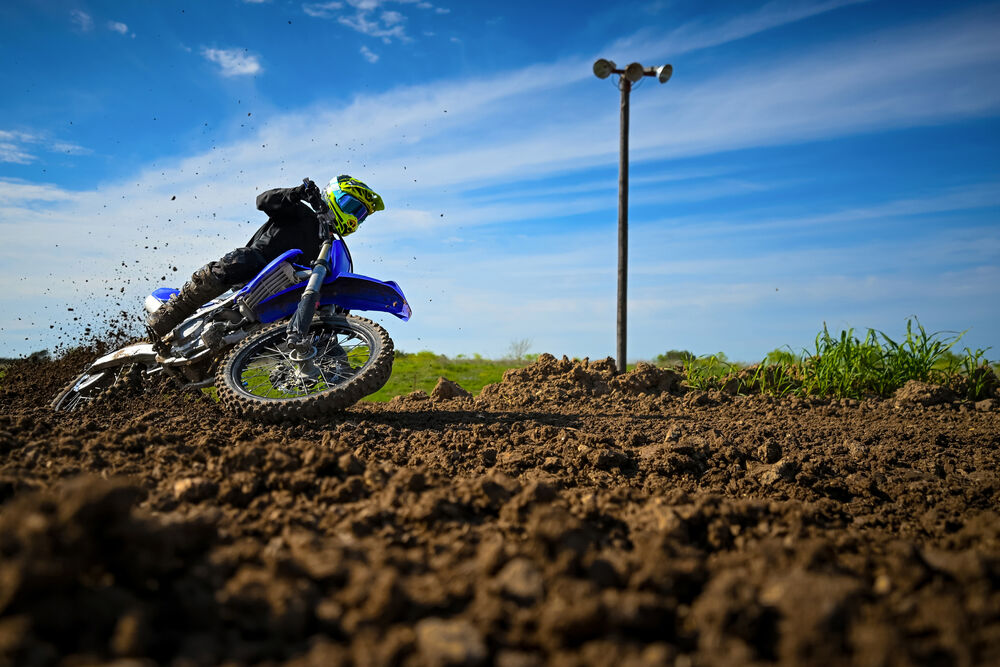
493-Point Phase-Detection AF
Covering the full sensor area, the Z6 III's flagship EXPEED 7 processor unlocks Nikon's flagship 493-point phase-detection AF system to realize fast and accurate focusing performance. This system is benefitted by the high-speed communication of the Z interface along with the speed of the sensor that enables AF readings to occur at up to 120 fps.

This focusing system also supports working in low-light conditions with a Starlight mode that permits focusing down to -10 EV to greatly benefit astrophotography, concert, and other nighttime shooting applications. Featuring the highest native ISO in a Z-series camera at ISO 64000, the autofocus is also useful for working in difficult lighting conditions. The Backlit AF function uses separate pixels on the sensor that allows these areas to intentionally overexpose for focusing accuracy purposes without impacting the actual exposure of the recorded image.
A mainstay focusing mode in DSLRs, which debuted for mirrorless with the Z9, the Z6 III also includes 3D Tracking AF that pairs with subject detection to lock onto fast, erratically moving subjects that move parallel and perpendicular to the camera. Additionally, there are three Dynamic-Area AF modes, with a range of focus area sizes, for capturing a broad variety of moving subject types.

Subject Detection with Deep Learning Technology
Utilizing inherited algorithms and deep learning technology from the Z9, including sophisticated Subject Detection, the Z6 III can recognize a variety of distinct subject types, ranging from humans to animals to airplanes to bicycles. When working in Auto-Area AF, these subjects will automatically be detected, focused on, and tracked to ensure sharp focus when the subject is moving across the frame.
Eye-Detection AF, specifically, has been tuned for improved accuracy and refined recognition of eyes in the scene and can also be used in conjunction with custom Wide-Area AF for different subject shapes and sizes.
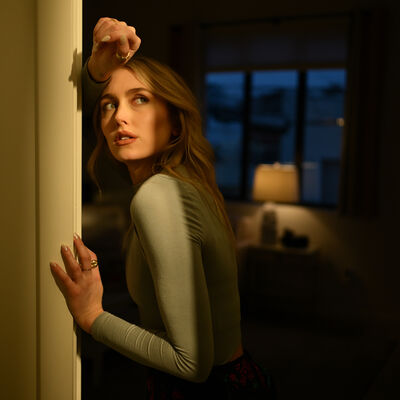
More Beautiful Portraits
Perfect for portraits, the Z6 III improves on the partially-stacked sensor's inherent capabilities with a series of processing tools and shooting functions to improve portraits:
- Portrait mode processes portraits for skin with natural texture and a rounded feel
- Rich Tone Portrait mode, a picture mode that produces more vivid results while capturing details of the subject's complexion and avoiding loss of detail in the highlights
- Flat Monochrome mode features gentle gradations from highlights to shadows, producing soft monochrome portraits
- Deep Tone Monochrome mode chooses slightly darker tones in the range from shadows to mid-tones, with brightness rapidly increasing as tones progress from mid-tones to highlights
- Skin softening can be used on up to three subjects in a shot and slightly blurs the skin for a more pleasing texture while still retaining essential sharpness on eyes and hair
- Manual white balance control is more intuitive when making adjustments and Auto WB has also been optimized for human subjects
- Take full advantage of Nikon's portrait modes by pairing the Z6 III with one of Nikon's portrait Z lenses, like the 50mm f/1.2 S, the 85mm f/1.2 S, or the 135mm f/1.8 S Plena
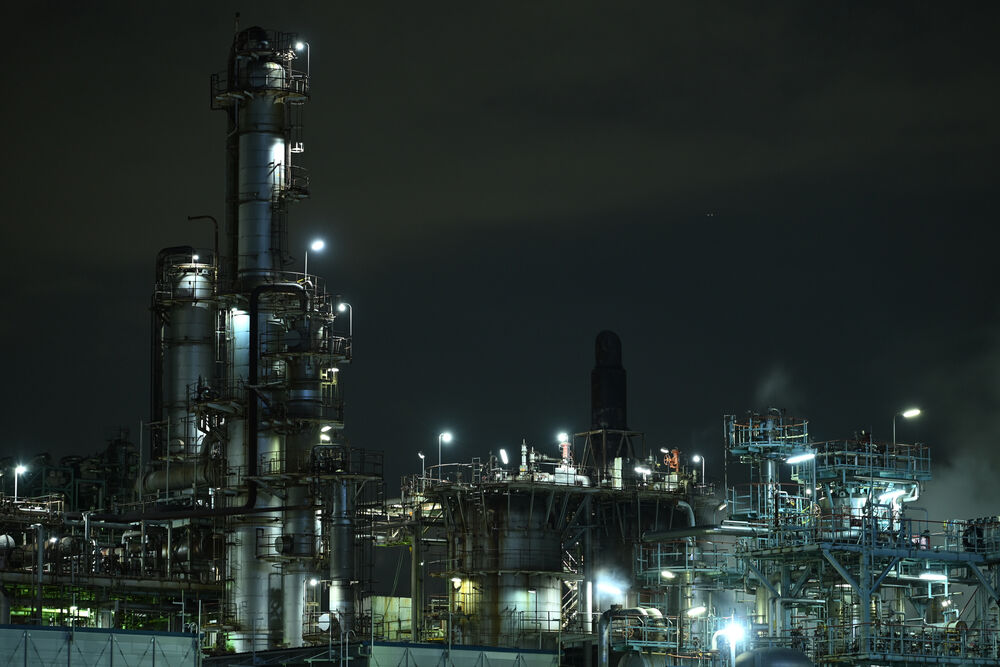
Pixel Shift Technology
Produce ultra-high resolution images at up to approximately 96 megapixels using pixel shift technology. By slightly shifting the image sensor between shots - selectable between 4 and 32 shots per image, with more shots meaning more detail - users can merge the images in NX Studio after shooting to create a single image with enhanced resolution, texture, and color. The shooting method also also reduces noise, moiré, and false colors. Pixel Shift photography benefits archival, landscape, architecture, fine art, macro, and film digitizing applications, and achieves its best results when working with a tripod.
Professional Level Video
Internal 6K60 and 4K 120 Recording
Equally capable for video, the Z6 III approaches the Z9's recording capabilities here, as well, with a variety of resolutions and frame rates available up to 6K.
Using full pixel readout, 6K60p video can be recorded with continuous shooting, while 4K and Full HD recording is also possible in a variety of frame rates, including full-frame 4K recording at up to 120p and Full HD recording at 240p for slow-motion playback.
N-RAW and ProRes RAW Video
Internal 12-bit raw raw recording at up to 6K 60p in the N-RAW format is supported along with internal ProRES RAW HQ. Raw recording offers greater tonal and color latitude and can improve dynamic range, benefitting color grading needs and post-production flexibility.
- N-RAW is Nikon's own raw recording format that offers impressively small file sizes compared to other raw formats as well as the ability to create MP4 proxies for more efficient previewing or transferring.
- N-RAW recording is available at up to 6K at 60p and ProRes RAW is also available at up to 6K and 30p.
ProRes and H.265 10-Bit Recording
Internal recording is also supported with 10-bit color and 4:2:2 sampling in the ProRes 422 HQ codec and 4:2:0 sampling in the H.265 codec at 5.4K 30p and 5.4K 60p, respectively.
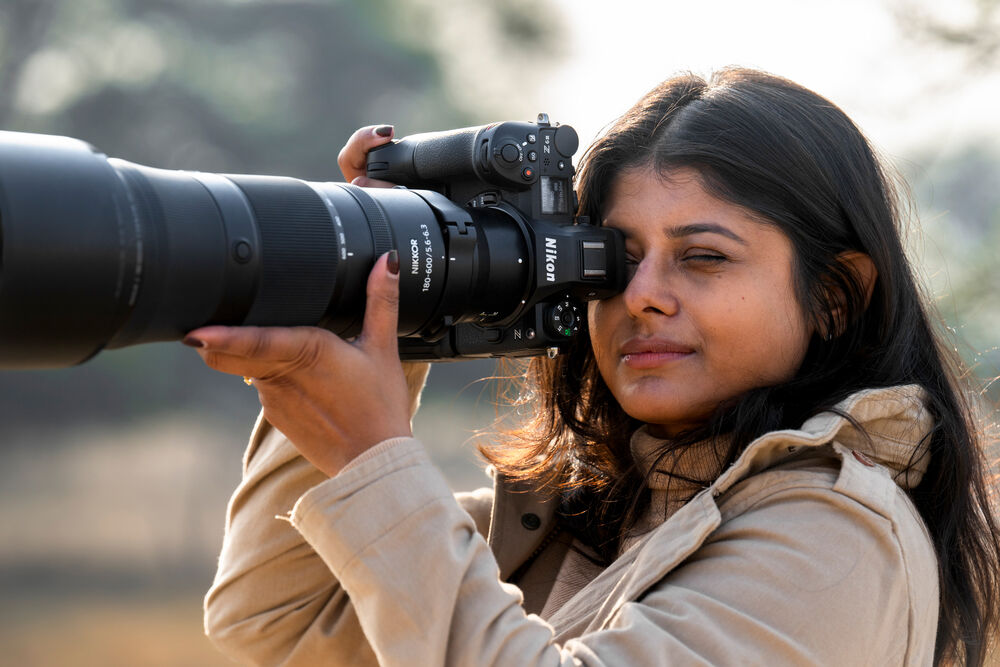
Nikon's Brightest Viewfinder
The Z6 III's sensor-processor combo has allowed Nikon to give the Z6 III the brightest electronic viewfinder on any of its cameras. At 4000 nits, it's 33% brighter than the flagship Z9, making a subject's details visible even in bright sunlight. Its 5,760,000 dot resolution is also a first for a Nikon EVF, aiding with autofocus by showing the subject recognition square. This EVF also features a high fps function, which ups the EVF's refresh rate to 120 fps for smoother, lifelike viewing. Finally, the Z6 III's EVF also features a higher dynamic range and is compatible with a DCI-P3 color gamut - the first of its kind in a mirrorless camera - for approximating real-world color when taking the shot.

170° Vari-Angle LCD
The Z6 III incorporates a unique 3.2" 2.1m-dot touchscreen LCD that features 170° vari-angle mobility to better support working from high and low angles, regardless if shooting in the horizontal or vertical orientation. This allows for easier viewing from a variety of positions and the user interface orientation will also shift depending on how the camera is held.
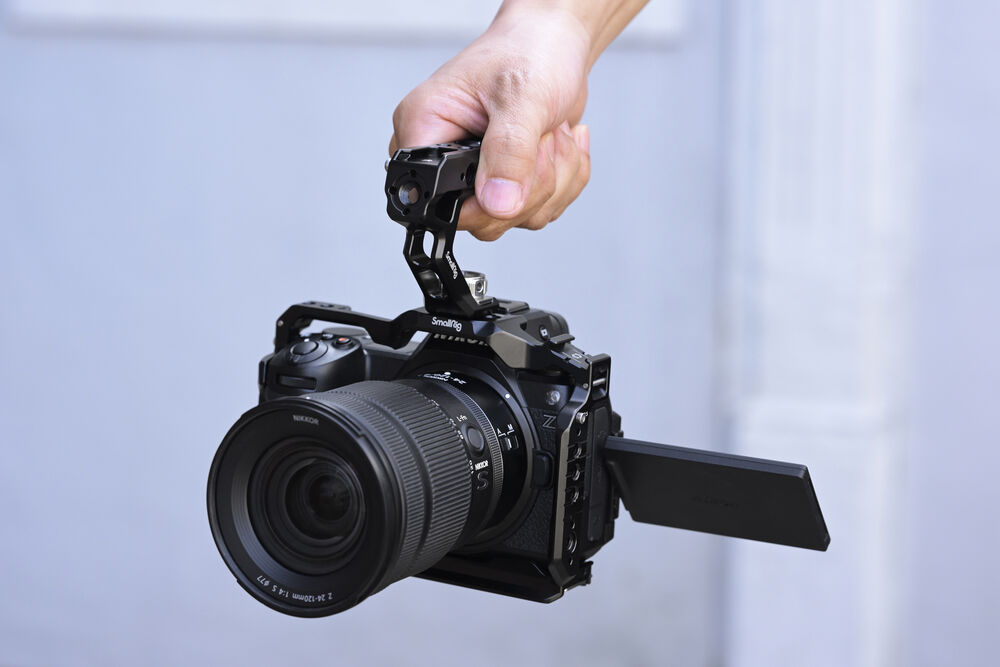
Body Design
- Dual card slots-one CFexpress Type B slot and one UHS-II SD slot-allow for flexible file saving. The CFx slot is suitable for data-intensive applications, like 6K recording and high-speed burst shooting, while the SD slot retains compatibility with the popular storage format. Additionally, the CFx B slot is also compatible with XQD memory cards.
- Pair the Z6 III with the optional MB-N14 Power Battery Pack grip for improved ergonomics when shooting vertical and up to 1.9x the battery life.
- The smaller, lighter design makes the Z6 III an ideal candidate for rigging or use on a gimbal for video use.
- Premium weather sealing protects against dust and moisture for confident use in harsh climates.
- In-body Vibration Reduction now supports Synchro VR to achieve up to 8 stops of camera shake compensation when used with select Z lenses.
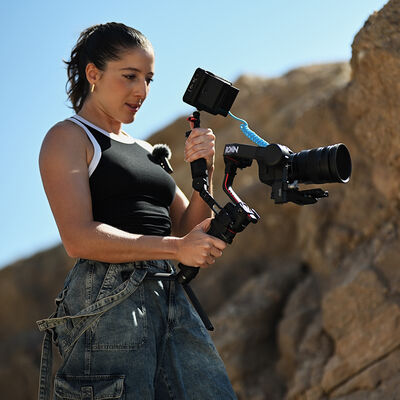
Versatile Connectivity
Matching the professional build quality, the Z6 III is fitted with a variety of connectivity options to suit various workflow needs:
- Another Nikon first, the Z6 III features direct-to-cloud connectivity with Nikon Imaging Cloud for file transfer and access to Nikon's imaging recipes for creative color grading
- Sync timecodes using Ultrasync Blue from Atmos, connecting multiple Z6 III camera bodies for multi-camera production setups
- Full-size HDMI port for outputting video to an external recorder or monitor
- 3.5mm headphone port and a new line-in port for on-board audio monitoring and high-quality audio input directly into the camera
- One USB-C port that supports file transfers and tethering as well as power delivery and battery charging
- USB-C communication terminal supports USB-LAN connectivity when paired with an optional USB-C to Ethernet adapter. This enables a 1000BASE-T wired LAN connection for transferring files over FTP
- 10-pin port offers wide accessories and remote connectivity
- Bluetooth and Wi-Fi (2.4 and 5 GHz) permit wireless transferring of files, remote camera control via a mobile device, and works in conjunction with the NX Mobile Air app for file management
Nikon Z6 III Overview
Key Features
- 24.5MP Partially-Stacked CMOS Sensor
- EXPEED 7 Image Processor
- 6K 60p N-RAW, 6K 30p ProRes RAW
- 4K 120p, Full HD 240p Slow Motion Video
- Up to 20 fps Raw, 60 fps JPEG Shooting
- Blackout-Free, 5760k-Dot EVF
- 493-Point AF, AI-Based Subject Detection
- 3.2" 4-Axis Tilting Touchscreen LCD
- CFx Type B & SD Memory Card Slots
- NIKKOR Z 24-70mm f/4 S Lens
Sporting a new and inspired partially-stacked sensor design, the Nikon Z6 III Mirrorless Camera unlocks a number of flagship-level upgrades for this mid-range camera, including faster and more precise autofocus, professional-level 6K internal raw video, pre-capture at up to 120 fps, and a smooth, bright, colorful EVF. Taken together, these upgrades make this mirrorless monster an ideal choice for aspiring professionals in search of an all-around, affordable camera.
Newly Designed Sensor and Flagship Processing

24.5MP Partially-Stacked CMOS Sensor
The Z6 III is Nikon's first camera to to feature a partially stacked sensor design for faster scans and readouts than its predecessor, as well as reducing rolling shutter. Additionally, this sensor design unlocks many of the flagship-level features in the camera, like faster autofocus, a smoother EVF experience, faster continuous shooting speeds, and higher frame rates when shooting video.
EXPEED 7 Image Processor
Complementing the sensor is the EXPEED 7 processing engine, found in the top-of-the-line Z8 and Z9 mirrorless cameras an which offers speeds approximately 10x faster than the Z6II. This engine works in conjunction with the partially-stacked sensor design to realize impressively fast AF speeds, burst shooting rates, a high buffer capacity, fluid video performance, and quick all-around handling.

- Top continuous shooting speeds of 20 fps when shooting in raw, up to 60 fps when shooting in full-frame JPEG, and 120 fps when shooting JPEGs using a DX crop, with all rates supporting full AF/AE performance.
- Able to buffer over 1000 images in a burst when using the electronic shutter, meaning image sequences can be recorded for approximately 50 seconds continuously.

- Pre-Release Capture at up to 120 fps helps make decisive moment shots easier by recording frames in a burst for up to a second prior to actually releasing the shutter. When this feature is activated, burst shooting will commence when the shutter is half-pressed and the buffer will retain up to 4 seconds' worth of frames after fully pressing the shutter.
- Electronic shutter affords a top shutter speed of 1/16,000 sec for working in the brightest conditions with wider apertures.
- Partially-stacked sensor design reduces rolling shutter distortion so fast-moving subjects, like a golf club, tennis racket, or baseball bat, do not appear distorted when working with shutter speeds up to 1/16,000 sec.
- AF calculations are done at a 120 fps rate to keep up with fast continuous shooting speeds.
Fast and Intelligent AF

493-Point Phase-Detection AF
Covering the full sensor area, the Z6 III's flagship EXPEED 7 processor unlocks Nikon's flagship 493-point phase-detection AF system to realize fast and accurate focusing performance. This system is benefitted by the high-speed communication of the Z interface along with the speed of the sensor that enables AF readings to occur at up to 120 fps.

This focusing system also supports working in low-light conditions with a Starlight mode that permits focusing down to -10 EV to greatly benefit astrophotography, concert, and other nighttime shooting applications. Featuring the highest native ISO in a Z-series camera at ISO 64000, the autofocus is also useful for working in difficult lighting conditions. The Backlit AF function uses separate pixels on the sensor that allows these areas to intentionally overexpose for focusing accuracy purposes without impacting the actual exposure of the recorded image.
A mainstay focusing mode in DSLRs, which debuted for mirrorless with the Z9, the Z6 III also includes 3D Tracking AF that pairs with subject detection to lock onto fast, erratically moving subjects that move parallel and perpendicular to the camera. Additionally, there are three Dynamic-Area AF modes, with a range of focus area sizes, for capturing a broad variety of moving subject types.

Subject Detection with Deep Learning Technology
Utilizing inherited algorithms and deep learning technology from the Z9, including sophisticated Subject Detection, the Z6 III can recognize a variety of distinct subject types, ranging from humans to animals to airplanes to bicycles. When working in Auto-Area AF, these subjects will automatically be detected, focused on, and tracked to ensure sharp focus when the subject is moving across the frame.
Eye-Detection AF, specifically, has been tuned for improved accuracy and refined recognition of eyes in the scene and can also be used in conjunction with custom Wide-Area AF for different subject shapes and sizes.

More Beautiful Portraits
Perfect for portraits, the Z6 III improves on the partially-stacked sensor's inherent capabilities with a series of processing tools and shooting functions to improve portraits:
- Portrait mode processes portraits for skin with natural texture and a rounded feel
- Rich Tone Portrait mode, a picture mode that produces more vivid results while capturing details of the subject's complexion and avoiding loss of detail in the highlights
- Flat Monochrome mode features gentle gradations from highlights to shadows, producing soft monochrome portraits
- Deep Tone Monochrome mode chooses slightly darker tones in the range from shadows to mid-tones, with brightness rapidly increasing as tones progress from mid-tones to highlights
- Skin softening can be used on up to three subjects in a shot and slightly blurs the skin for a more pleasing texture while still retaining essential sharpness on eyes and hair
- Manual white balance control is more intuitive when making adjustments and Auto WB has also been optimized for human subjects
- Take full advantage of Nikon's portrait modes by pairing the Z6 III with one of Nikon's portrait Z lenses, like the 50mm f/1.2 S, the 85mm f/1.2 S, or the 135mm f/1.8 S Plena

Pixel Shift Technology
Produce ultra-high resolution images at up to approximately 96 megapixels using pixel shift technology. By slightly shifting the image sensor between shots - selectable between 4 and 32 shots per image, with more shots meaning more detail - users can merge the images in NX Studio after shooting to create a single image with enhanced resolution, texture, and color. The shooting method also also reduces noise, moiré, and false colors. Pixel Shift photography benefits archival, landscape, architecture, fine art, macro, and film digitizing applications, and achieves its best results when working with a tripod.
Professional Level Video
Internal 6K60 and 4K 120 Recording
Equally capable for video, the Z6 III approaches the Z9's recording capabilities here, as well, with a variety of resolutions and frame rates available up to 6K.
Using full pixel readout, 6K60p video can be recorded with continuous shooting, while 4K and Full HD recording is also possible in a variety of frame rates, including full-frame 4K recording at up to 120p and Full HD recording at 240p for slow-motion playback.
N-RAW and ProRes RAW Video
Internal 12-bit raw raw recording at up to 6K 60p in the N-RAW format is supported along with internal ProRES RAW HQ. Raw recording offers greater tonal and color latitude and can improve dynamic range, benefitting color grading needs and post-production flexibility.
- N-RAW is Nikon's own raw recording format that offers impressively small file sizes compared to other raw formats as well as the ability to create MP4 proxies for more efficient previewing or transferring.
- N-RAW recording is available at up to 6K at 60p and ProRes RAW is also available at up to 6K and 30p.
ProRes and H.265 10-Bit Recording
Internal recording is also supported with 10-bit color and 4:2:2 sampling in the ProRes 422 HQ codec and 4:2:0 sampling in the H.265 codec at 5.4K 30p and 5.4K 60p, respectively.

Nikon's Brightest Viewfinder
The Z6 III's sensor-processor combo has allowed Nikon to give the Z6 III the brightest electronic viewfinder on any of its cameras. At 4000 nits, it's 33% brighter than the flagship Z9, making a subject's details visible even in bright sunlight. Its 5,760,000 dot resolution is also a first for a Nikon EVF, aiding with autofocus by showing the subject recognition square. This EVF also features a high fps function, which ups the EVF's refresh rate to 120 fps for smoother, lifelike viewing. Finally, the Z6 III's EVF also features a higher dynamic range and is compatible with a DCI-P3 color gamut - the first of its kind in a mirrorless camera - for approximating real-world color when taking the shot.

170° Vari-Angle LCD
The Z6 III incorporates a unique 3.2" 2.1m-dot touchscreen LCD that features 170° vari-angle mobility to better support working from high and low angles, regardless if shooting in the horizontal or vertical orientation. This allows for easier viewing from a variety of positions and the user interface orientation will also shift depending on how the camera is held.

Body Design
- Dual card slots-one CFexpress Type B slot and one UHS-II SD slot-allow for flexible file saving. The CFx slot is suitable for data-intensive applications, like 6K recording and high-speed burst shooting, while the SD slot retains compatibility with the popular storage format. Additionally, the CFx B slot is also compatible with XQD memory cards.
- Pair the Z6 III with the optional MB-N14 Power Battery Pack grip for improved ergonomics when shooting vertical and up to 1.9x the battery life.
- The smaller, lighter design makes the Z6 III an ideal candidate for rigging or use on a gimbal for video use.
- Premium weather sealing protects against dust and moisture for confident use in harsh climates.
- In-body Vibration Reduction now supports Synchro VR to achieve up to 8 stops of camera shake compensation when used with select Z lenses.

Versatile Connectivity
Matching the professional build quality, the Z6 III is fitted with a variety of connectivity options to suit various workflow needs:
- Another Nikon first, the Z6 III features direct-to-cloud connectivity with Nikon Imaging Cloud for file transfer and access to Nikon's imaging recipes for creative color grading
- Sync timecodes using Ultrasync Blue from Atmos, connecting multiple Z6 III camera bodies for multi-camera production setups
- Full-size HDMI port for outputting video to an external recorder or monitor
- 3.5mm headphone port and a new line-in port for on-board audio monitoring and high-quality audio input directly into the camera
- One USB-C port that supports file transfers and tethering as well as power delivery and battery charging
- USB-C communication terminal supports USB-LAN connectivity when paired with an optional USB-C to Ethernet adapter. This enables a 1000BASE-T wired LAN connection for transferring files over FTP
- 10-pin port offers wide accessories and remote connectivity
- Bluetooth and Wi-Fi (2.4 and 5 GHz) permit wireless transferring of files, remote camera control via a mobile device, and works in conjunction with the NX Mobile Air app for file management

Nikon Z6 III Overview
Key Features
- 24.5MP Partially-Stacked CMOS Sensor
- EXPEED 7 Image Processor
- 6K 60p N-RAW, 6K 30p ProRes RAW
- 4K 120p, Full HD 240p Slow Motion Video
- Up to 20 fps Raw, 60 fps JPEG Shooting
- Blackout-Free, 5760k-Dot EVF
- 493-Point AF, AI-Based Subject Detection
- 3.2" 4-Axis Tilting Touchscreen LCD
- CFexpress Type B & SD Memory Card Slots
- Camera-to-Cloud Direct Connectivity
Sporting a new and inspired partially-stacked sensor design, the Nikon Z6 III Mirrorless Camera unlocks a number of flagship-level upgrades for this mid-range camera, including faster and more precise autofocus, professional-level 6K internal raw video, pre-capture at up to 120 fps, and a smooth, bright, colorful EVF. Taken together, these upgrades make this mirrorless monster an ideal choice for aspiring professionals in search of an all-around, affordable camera.
Newly Designed Sensor and Flagship Processing

24.5MP Partially-Stacked CMOS Sensor
The Z6 III is Nikon's first camera to to feature a partially stacked sensor design for faster scans and readouts than its predecessor, as well as reducing rolling shutter. Additionally, this sensor design unlocks many of the flagship-level features in the camera, like faster autofocus, a smoother EVF experience, faster continuous shooting speeds, and higher frame rates when shooting video.
EXPEED 7 Image Processor
Complementing the sensor is the EXPEED 7 processing engine, found in the top-of-the-line Z8 and Z9 mirrorless cameras an which offers speeds approximately 10x faster than the Z6II. This engine works in conjunction with the partially-stacked sensor design to realize impressively fast AF speeds, burst shooting rates, a high buffer capacity, fluid video performance, and quick all-around handling.

- Top continuous shooting speeds of 20 fps when shooting in raw, up to 60 fps when shooting in full-frame JPEG, and 120 fps when shooting JPEGs using a DX crop, with all rates supporting full AF/AE performance.
- Able to buffer over 1000 images in a burst when using the electronic shutter, meaning image sequences can be recorded for approximately 50 seconds continuously.

- Pre-Release Capture at up to 120 fps helps make decisive moment shots easier by recording frames in a burst for up to a second prior to actually releasing the shutter. When this feature is activated, burst shooting will commence when the shutter is half-pressed and the buffer will retain up to 4 seconds' worth of frames after fully pressing the shutter.
- Electronic shutter affords a top shutter speed of 1/16,000 sec for working in the brightest conditions with wider apertures.
- Partially-stacked sensor design reduces rolling shutter distortion so fast-moving subjects, like a golf club, tennis racket, or baseball bat, do not appear distorted when working with shutter speeds up to 1/16,000 sec.
- AF calculations are done at a 120 fps rate to keep up with fast continuous shooting speeds.
Fast and Intelligent AF

493-Point Phase-Detection AF
Covering the full sensor area, the Z6 III's flagship EXPEED 7 processor unlocks Nikon's flagship 493-point phase-detection AF system to realize fast and accurate focusing performance. This system is benefitted by the high-speed communication of the Z interface along with the speed of the sensor that enables AF readings to occur at up to 120 fps.

This focusing system also supports working in low-light conditions with a Starlight mode that permits focusing down to -10 EV to greatly benefit astrophotography, concert, and other nighttime shooting applications. Featuring the highest native ISO in a Z-series camera at ISO 64000, the autofocus is also useful for working in difficult lighting conditions. The Backlit AF function uses separate pixels on the sensor that allows these areas to intentionally overexpose for focusing accuracy purposes without impacting the actual exposure of the recorded image.
A mainstay focusing mode in DSLRs, which debuted for mirrorless with the Z9, the Z6 III also includes 3D Tracking AF that pairs with subject detection to lock onto fast, erratically moving subjects that move parallel and perpendicular to the camera. Additionally, there are three Dynamic-Area AF modes, with a range of focus area sizes, for capturing a broad variety of moving subject types.

Subject Detection with Deep Learning Technology
Utilizing inherited algorithms and deep learning technology from the Z9, including sophisticated Subject Detection, the Z6 III can recognize a variety of distinct subject types, ranging from humans to animals to airplanes to bicycles. When working in Auto-Area AF, these subjects will automatically be detected, focused on, and tracked to ensure sharp focus when the subject is moving across the frame.
Eye-Detection AF, specifically, has been tuned for improved accuracy and refined recognition of eyes in the scene and can also be used in conjunction with custom Wide-Area AF for different subject shapes and sizes.

More Beautiful Portraits
Perfect for portraits, the Z6 III improves on the partially-stacked sensor's inherent capabilities with a series of processing tools and shooting functions to improve portraits:
- Portrait mode processes portraits for skin with natural texture and a rounded feel
- Rich Tone Portrait mode, a picture mode that produces more vivid results while capturing details of the subject's complexion and avoiding loss of detail in the highlights
- Flat Monochrome mode features gentle gradations from highlights to shadows, producing soft monochrome portraits
- Deep Tone Monochrome mode chooses slightly darker tones in the range from shadows to mid-tones, with brightness rapidly increasing as tones progress from mid-tones to highlights
- Skin softening can be used on up to three subjects in a shot and slightly blurs the skin for a more pleasing texture while still retaining essential sharpness on eyes and hair
- Manual white balance control is more intuitive when making adjustments and Auto WB has also been optimized for human subjects
- Take full advantage of Nikon's portrait modes by pairing the Z6 III with one of Nikon's portrait Z lenses, like the 50mm f/1.2 S, the 85mm f/1.2 S, or the 135mm f/1.8 S Plena

Pixel Shift Technology
Produce ultra-high resolution images at up to approximately 96 megapixels using pixel shift technology. By slightly shifting the image sensor between shots - selectable between 4 and 32 shots per image, with more shots meaning more detail - users can merge the images in NX Studio after shooting to create a single image with enhanced resolution, texture, and color. The shooting method also also reduces noise, moiré, and false colors. Pixel Shift photography benefits archival, landscape, architecture, fine art, macro, and film digitizing applications, and achieves its best results when working with a tripod.
Professional Level Video
Internal 6K60 and 4K 120 Recording
Equally capable for video, the Z6 III approaches the Z9's recording capabilities here, as well, with a variety of resolutions and frame rates available up to 6K.
Using full pixel readout, 6K60p video can be recorded with continuous shooting, while 4K and Full HD recording is also possible in a variety of frame rates, including full-frame 4K recording at up to 120p and Full HD recording at 240p for slow-motion playback.
N-RAW and ProRes RAW Video
Internal 12-bit raw raw recording at up to 6K 60p in the N-RAW format is supported along with internal ProRES RAW HQ. Raw recording offers greater tonal and color latitude and can improve dynamic range, benefitting color grading needs and post-production flexibility.
- N-RAW is Nikon's own raw recording format that offers impressively small file sizes compared to other raw formats as well as the ability to create MP4 proxies for more efficient previewing or transferring.
- N-RAW recording is available at up to 6K at 60p and ProRes RAW is also available at up to 6K and 30p.
ProRes and H.265 10-Bit Recording
Internal recording is also supported with 10-bit color and 4:2:2 sampling in the ProRes 422 HQ codec and 4:2:0 sampling in the H.265 codec at 5.4K 30p and 5.4K 60p, respectively.

Nikon's Brightest Viewfinder
The Z6 III's sensor-processor combo has allowed Nikon to give the Z6 III the brightest electronic viewfinder on any of its cameras. At 4000 nits, it's 33% brighter than the flagship Z9, making a subject's details visible even in bright sunlight. Its 5,760,000 dot resolution is also a first for a Nikon EVF, aiding with autofocus by showing the subject recognition square. This EVF also features a high fps function, which ups the EVF's refresh rate to 120 fps for smoother, lifelike viewing. Finally, the Z6 III's EVF also features a higher dynamic range and is compatible with a DCI-P3 color gamut - the first of its kind in a mirrorless camera - for approximating real-world color when taking the shot.

170° Vari-Angle LCD
The Z6 III incorporates a unique 3.2" 2.1m-dot touchscreen LCD that features 170° vari-angle mobility to better support working from high and low angles, regardless if shooting in the horizontal or vertical orientation. This allows for easier viewing from a variety of positions and the user interface orientation will also shift depending on how the camera is held.

Body Design
- Dual card slots-one CFexpress Type B slot and one UHS-II SD slot-allow for flexible file saving. The CFx slot is suitable for data-intensive applications, like 6K recording and high-speed burst shooting, while the SD slot retains compatibility with the popular storage format. Additionally, the CFx B slot is also compatible with XQD memory cards.
- Pair the Z6 III with the optional MB-N14 Power Battery Pack grip for improved ergonomics when shooting vertical and up to 1.9x the battery life.
- The smaller, lighter design makes the Z6 III an ideal candidate for rigging or use on a gimbal for video use.
- Premium weather sealing protects against dust and moisture for confident use in harsh climates.
- In-body Vibration Reduction now supports Synchro VR to achieve up to 8 stops of camera shake compensation when used with select Z lenses.

Versatile Connectivity
Matching the professional build quality, the Z6 III is fitted with a variety of connectivity options to suit various workflow needs:
- Another Nikon first, the Z6 III features direct-to-cloud connectivity with Nikon Imaging Cloud for file transfer and access to Nikon's imaging recipes for creative color grading
- Sync timecodes using Ultrasync Blue from Atmos, connecting multiple Z6 III camera bodies for multi-camera production setups
- Full-size HDMI port for outputting video to an external recorder or monitor
- 3.5mm headphone port and a new line-in port for on-board audio monitoring and high-quality audio input directly into the camera
- One USB-C port that supports file transfers and tethering as well as power delivery and battery charging
- USB-C communication terminal supports USB-LAN connectivity when paired with an optional USB-C to Ethernet adapter. This enables a 1000BASE-T wired LAN connection for transferring files over FTP
- 10-pin port offers wide accessories and remote connectivity
- Bluetooth and Wi-Fi (2.4 and 5 GHz) permit wireless transferring of files, remote camera control via a mobile device, and works in conjunction with the NX Mobile Air app for file management

Nikon Zf Overview
Key Features
- 24.5MP FX-Format BSI CMOS Sensor
- EXPEED 7 Image Processor
- UHD 4K 30p Video and Full HD 120p Video
- AF Subject Recognition with 3D Tracking
- 5-Axis In-Body Vibration Reduction
- Focus-Point Stabilization
- 3.2" Vari-Angle Touchscreen
- 96MP High-Res Mode
- NIKKOR Z 24-70mm f/4 S Lens
Nikon Zf Mirrorless Camera
Iconic Design Inspiring Elite Performance
The most powerful entry yet in Nikon's line of digital throwbacks, the full-frame, creator-inspired Zf Mirrorless Camera proves once again that good style never goes away. While the camera's body design retrieves the filmic, steel-feel functionalism of vintage SLRs, its insides are nonetheless outfitted with the latest in Z-series features and capabilities, turning the Zf's iconic silhouette into a modern and tactile shooter that uses its advanced tech to deliver timeless imagery.
Immersive and Intuitive Design
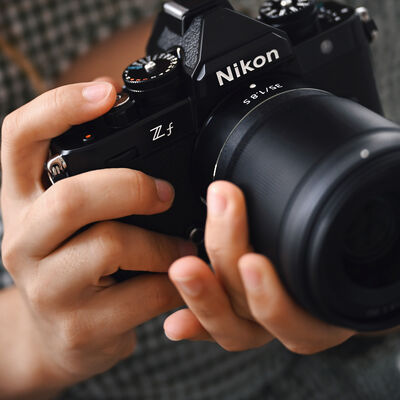
Recalling the FM2, Nikon's mechanical workhorse of yesteryear, the Zf's machined edges, knurled dials, and marbled texture are designed to fully immerse the user in the sensual experience of operating a beautiful machine. Made from precision-carved aluminum, the dials for shutter speed, ISO, and exposure compensation feature engraved markings for superlative manual control. The mechanical shutter fires with an audible, authoritative click. A dedicated black-and-white mode with two monochrome recipes is available at the tip of a finger as well.
This intuitive, haptic-friendly design doesn't apply solely to the camera's retro-styled controls. The camera's electronic viewfinder, which lies in a prism-shaped housing that is as pleasing to the bony orbit as it is to the eye, can now be manipulated by touching the 3.2", vari-angle rear LCD screen, allowing the user to move focus points, select a subject to track, and toggle between display modes all while the eye remains resting against viewfinder. The rear screen is also fully articulating and front-facing, allowing for ease of navigation and operation at high and low angles.
Other design features include:
- Dual memory card slots offering flexible file storage capabilities; one SD and one microSD permit overflow, segregated, and repetitive saving options.
- A robust magnesium alloy chassis is both dust and weather-resistant, allowing you to work in harsh climates and inclement conditions.
- Compatible with optional MC-N10 Remote Grip and AR-11 Soft Shutter Release.
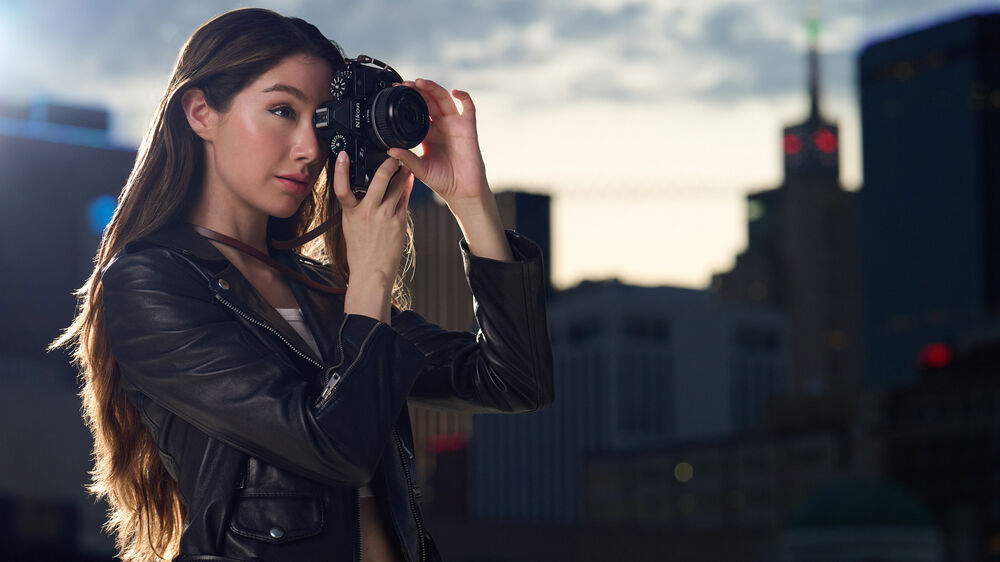
Full-Frame Sensor, Full-Speed Processor
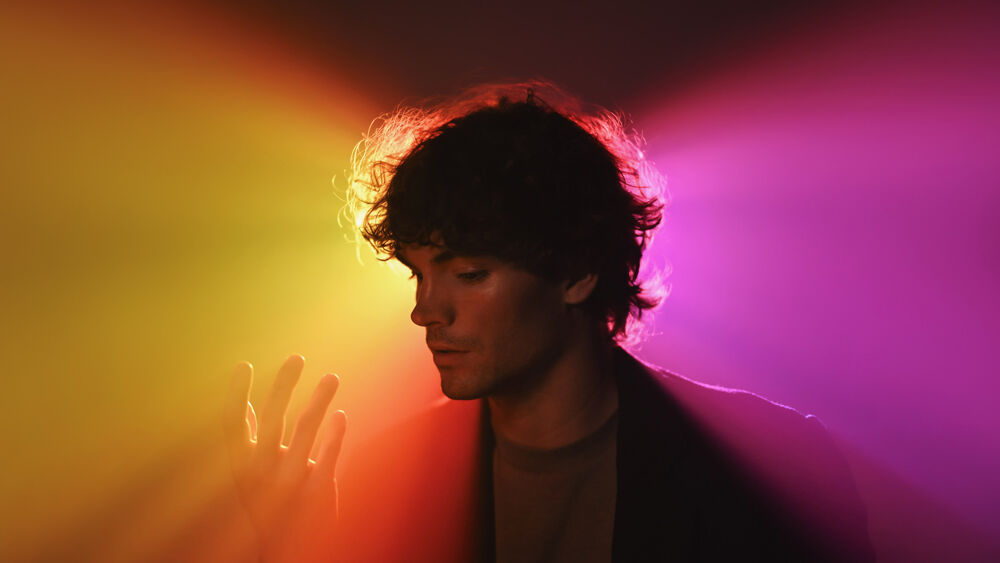
24.5MP FX-Format BSI CMOS Sensor
A 24.5MP BSI CMOS sensor is used for all-around shooting, impressive low-light image quality, and fast readout speeds to benefit continuous shooting, movies, and time-lapse recording. The back-illuminated design of the sensor also affords noticeably clean high-sensitivity output for reduced noise when working at high ISO values. Additionally, the Zf features a high-resolution photo mode that combines multiple exposures to create a single 96MP file.
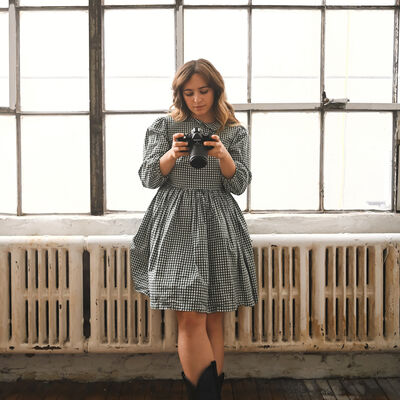
EXPEED 7 Image Processor
- Utilizing the same powerful processing engine used in the Z9 and Z8, the camera's EXPEED 7 Image processor works in conjunction with the sensor design to realize impressively fast AF speeds, burst shooting rates, a high buffer capacity, fluid video performance, and quick all-around handling.
- Enhanced with Deep Learning technology, the camera features an auto mode that analyzes your shooting situation and automatically adjusts aperture, ISO, and shutter speed to match your intentions. With this setting you can automatically capture portraits with beautiful background blur or have all the faces in focus for a group shot.
- Extremely fast 30 fps burst rate with silent mechanical shutter and 14 fps burst rate with mechanical shutter.
- Pre-release capture records up to 30 JPEGS a full second before shutter is released.
Advanced Video, Autofocus, and Stabilization
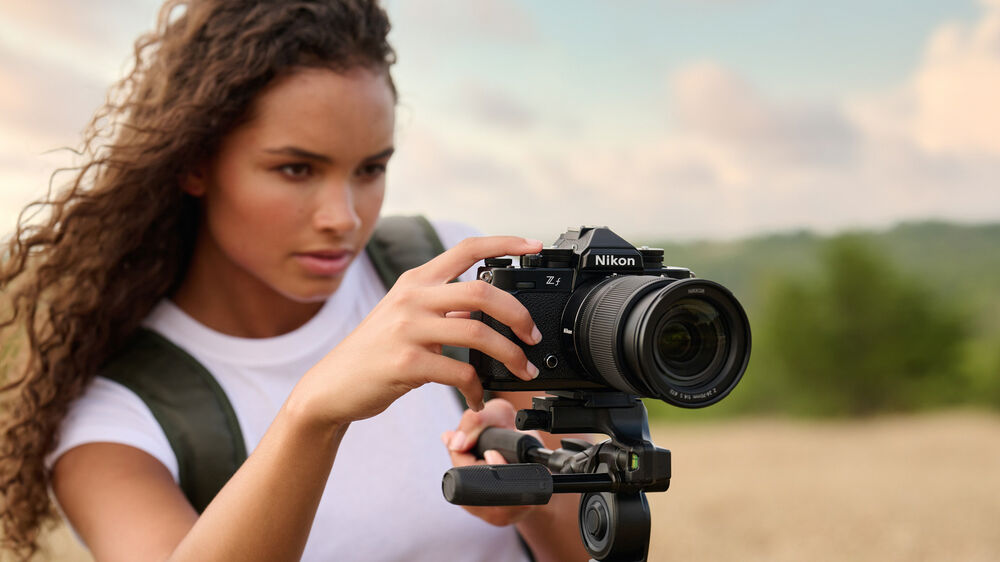
UHD 4K Recording and Versatile Video Control
- New shutter-priority exposure mode lets you record with a fixed shutter speed, making smooth adjustments to ISO and aperture to maintain even brightness in your shot.
- Matching the camera's high-end photo attributes, the Zf offers a variety of frame rates and resolutions for all your video needs. Oversampled from 6K, UHD 4K video recording is possible with full pixel readout up to 30p, and Full HD 1080p video recording is also supported up to 120p for slow motion playback.
- Internal recording up to 125 minutes directly to a memory card with 10-bit H.265 in SDR/HLG/N-log tone modes.
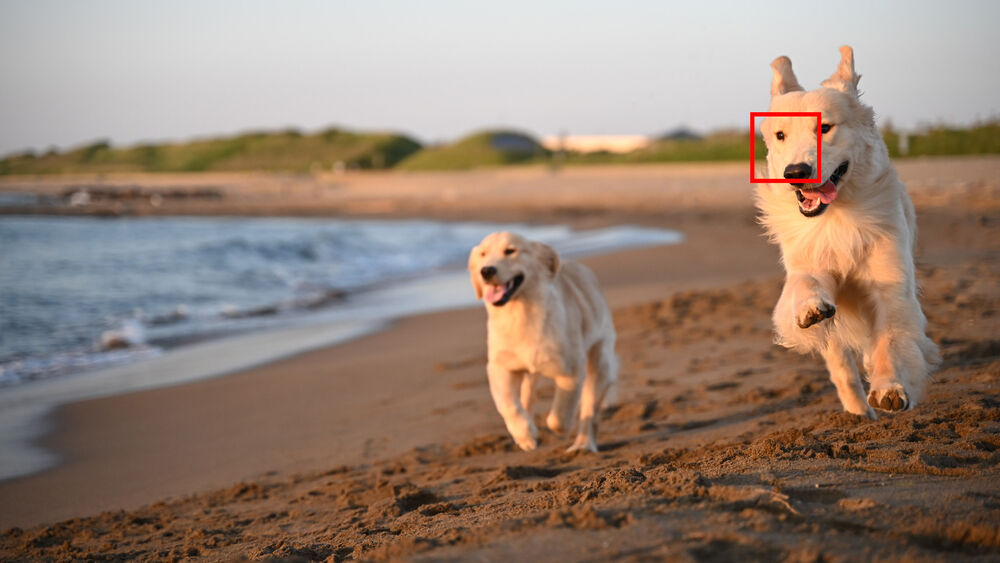
Fast and Intelligent AF
- Like the Z9 and Z8, the Zf's autofocus system recognizes a wide range of common subjects — people, cats, dogs, birds, bicycles, motorbikes, cars, aircraft, and trains — and uses Deep Learning technology to provide exactly the right focus and tracking for each.
- Eye-Detection AF for photo and video automatically locks onto the eyes of people, pets, and birds, even when they're extremely small in the frame. For the first time, the feature is also available for manual focus lenses, automatically magnifying the area around the eyes so you can quickly confirm sharp focus.
Vibration Reduction
- In-body 5-axis sensor-shift Vibration Reduction compensates for up to 8 stops of camera shake when paired with Z-mount lenses, letting you slow shutter speed an amazing 8.0 stops slower than would otherwise be possible without causing image blur. Additionally, this system also works with adapted F-mount lenses when using the optional FTZ Adapter, where 3-axis stabilization is used.
- Focus point vibration reduction system applies stabilization to the area around the active focus point, wherever it is in the frame, providing precise correction right where you need it.
Nikon NIKKOR Z 24-70mm f/4 S Lens
Covering a useful range of focal lengths, the NIKKOR Z 24-70mm f/4 S is a versatile zoom, spanning wide-angle to portrait-length perspectives. Its constant f/4 maximum aperture maintains a consistent exposure throughout the zoom range and also helps to realize a more compact and lightweight alternative to an f/2.8 zoom. In regard to the optical design, a unique aspherical extra-low dispersion element, in addition to three aspherical elements, is used to help reduce chromatic aberrations and distortions throughout the zoom range in order to achieve high image sharpness and clarity. Both Nano Crystal and Super Integrated Coatings have also been applied to control flare and ghosting for greater contrast and color rendering in bright and backlit conditions.
Complementing the optics, a stepping motor provides quick, quiet, and precise autofocus performance along with full-time manual focus override to suit both stills and video applications. A programmable control ring can be set for intuitive adjustment over a variety of camera and exposure settings. Additionally, the lens has a button-less retractable barrel to realize a more compact form factor when not in use.
Standard zoom covers a wide-angle to portrait-length range and is designed for FX-format Z-mount mirrorless cameras.
Constant f/4 maximum aperture affords consistent performance throughout the zoom range and also contributes to the relatively lightweight design and compact form factor.
A unique aspherical extra-low dispersion element is incorporated into the optical design, along with three additional aspherical elements, to greatly reduce chromatic and spherical aberrations, distortion, coma (comatic aberration), and flare for consistent edge-to-edge sharpness and illumination.
A Nano Crystal Coat, along with a Super Integrated Coating, has been applied to lens elements to minimize surface and internal reflections for a marked reduction in lens flare and ghosting.
Stepping motor delivers impressively smooth, quiet, and fast autofocus performance that is well-suited to both stills and video applications. Full-time manual focus override is also possible and an internal focusing design is used, where only the internal lens groups are moved during focusing, to maintain the overall length of the lens during use and to promote faster focusing speeds.
Programmable Control Ring is, by default, set to adjust manual focus, but can also be used to control aperture or exposure compensation.
Specialized electromagnetic aperture mechanism provides greater exposure control stability that is especially beneficial when working with fast continuous shooting rates.
Rounded seven-blade diaphragm promotes a pleasing out of focus quality that benefits the use of shallow depth of field and selective focus techniques.
Exposed elements feature a fluorine coating that affords protection to the optical system against dust, grease, and water droplets.
Dust- and moisture-resistant lens barrel benefits the lens' use in inclement conditions.
Button-less retractable design maintains a compact form factor when the lens is not in use.

Nikon Zf Overview
Key Features
- 24.5MP FX-Format BSI CMOS Sensor
- EXPEED 7 Image Processor
- UHD 4K 30p Video and Full HD 120p Video
- AF Subject Recognition with 3D Tracking
- 5-Axis In-Body Vibration Reduction
- Focus-Point Stabilization
- 3.2" Vari-Angle Touchscreen
- 96MP High-Res Mode
- NIKKOR Z 40mm f/2 (SE) Lens
The most powerful entry yet in Nikon's line of digital throwbacks, the full-frame, creator-inspired Zf Mirrorless Camera proves once again that good style never goes away. While the camera's body design retrieves the filmic, steel-feel functionalism of vintage SLRs, its insides are nonetheless outfitted with the latest in Z-series features and capabilities, turning the Zf's iconic silhouette into a modern and tactile shooter that uses its advanced tech to deliver timeless imagery.
Immersive and Intuitive Design

Recalling the FM2, Nikon's mechanical workhorse of yesteryear, the Zf's machined edges, knurled dials, and marbled texture are designed to fully immerse the user in the sensual experience of operating a beautiful machine. Made from precision-carved aluminum, the dials for shutter speed, ISO, and exposure compensation feature engraved markings for superlative manual control. The mechanical shutter fires with an audible, authoritative click. A dedicated black-and-white mode with two monochrome recipes is available at the tip of a finger as well.
This intuitive, haptic-friendly design doesn't apply solely to the camera's retro-styled controls. The camera's electronic viewfinder, which lies in a prism-shaped housing that is as pleasing to the bony orbit as it is to the eye, can now be manipulated by touching the 3.2", vari-angle rear LCD screen, allowing the user to move focus points, select a subject to track, and toggle between display modes all while the eye remains resting against viewfinder. The rear screen is also fully articulating and front-facing, allowing for ease of navigation and operation at high and low angles.
Other design features include:
- Dual memory card slots offering flexible file storage capabilities; one SD and one microSD permit overflow, segregated, and repetitive saving options.
- A robust magnesium alloy chassis is both dust and weather-resistant, allowing you to work in harsh climates and inclement conditions.
- Compatible with optional MC-N10 Remote Grip and AR-11 Soft Shutter Release.

Full-Frame Sensor, Full-Speed Processor

24.5MP FX-Format BSI CMOS Sensor
A 24.5MP BSI CMOS sensor is used for all-around shooting, impressive low-light image quality, and fast readout speeds to benefit continuous shooting, movies, and time-lapse recording. The back-illuminated design of the sensor also affords noticeably clean high-sensitivity output for reduced noise when working at high ISO values. Additionally, the Zf features a high-resolution photo mode that combines multiple exposures to create a single 96MP file.

EXPEED 7 Image Processor
- Utilizing the same powerful processing engine used in the Z9 and Z8, the camera's EXPEED 7 Image processor works in conjunction with the sensor design to realize impressively fast AF speeds, burst shooting rates, a high buffer capacity, fluid video performance, and quick all-around handling.
- Enhanced with Deep Learning technology, the camera features an auto mode that analyzes your shooting situation and automatically adjusts aperture, ISO, and shutter speed to match your intentions. With this setting you can automatically capture portraits with beautiful background blur or have all the faces in focus for a group shot.
- Extremely fast 30 fps burst rate with silent mechanical shutter and 14 fps burst rate with mechanical shutter.
- Pre-release capture records up to 30 JPEGS a full second before shutter is released.
Advanced Video, Autofocus, and Stabilization

UHD 4K Recording and Versatile Video Control
- New shutter-priority exposure mode lets you record with a fixed shutter speed, making smooth adjustments to ISO and aperture to maintain even brightness in your shot.
- Matching the camera's high-end photo attributes, the Zf offers a variety of frame rates and resolutions for all your video needs. Oversampled from 6K, UHD 4K video recording is possible with full pixel readout up to 30p, and Full HD 1080p video recording is also supported up to 120p for slow motion playback.
- Internal recording up to 125 minutes directly to a memory card with 10-bit H.265 in SDR/HLG/N-log tone modes.

Fast and Intelligent AF
- Like the Z9 and Z8, the Zf's autofocus system recognizes a wide range of common subjects — people, cats, dogs, birds, bicycles, motorbikes, cars, aircraft, and trains — and uses Deep Learning technology to provide exactly the right focus and tracking for each.
- Eye-Detection AF for photo and video automatically locks onto the eyes of people, pets, and birds, even when they're extremely small in the frame. For the first time, the feature is also available for manual focus lenses, automatically magnifying the area around the eyes so you can quickly confirm sharp focus.
Vibration Reduction
- In-body 5-axis sensor-shift Vibration Reduction compensates for up to 8 stops of camera shake when paired with Z-mount lenses, letting you slow shutter speed an amazing 8.0 stops slower than would otherwise be possible without causing image blur. Additionally, this system also works with adapted F-mount lenses when using the optional FTZ Adapter, where 3-axis stabilization is used.
- Focus point vibration reduction system applies stabilization to the area around the active focus point, wherever it is in the frame, providing precise correction right where you need it.
Nikon NIKKOR Z 40mm f/2 (SE) Lens
Featuring a stylish, vintage-inspired design, the Nikon NIKKOR Z 40mm f/2 (SE) is a versatile, everyday prime straddling wide-angle and normal fields of view and featuring a bright f/2 maximum aperture. The distinct focal length is wide enough for spontaneous shooting but still tight enough for portraiture and selective focus shooting. Additionally, the lens's compact, portable form factor makes it perfect for walkaround shooting and equally well-suited to use on FX or DX-format camera bodies.
In terms of handling, a stepping motor AF system offers quiet and smooth focusing performance that benefits both stills and video capture and a programmable control ring can also be set for intuitive adjustment over a variety of camera and exposure settings.
This Special Edition version of the Z 40mm f/2 lens features a retro-inspired design with checked knurling on the lens body, a contrasting silver band, and a vintage NIKKOR logo and typeface that mimics the look of lenses used on classic Nikon FM film cameras.
Wide-normal prime lens is designed for FX-format Nikon Z-mount mirrorless cameras and can also be used with DX-format models, where it provides a 60mm equivalent focal length.
Bright f/2 maximum aperture excels in difficult lighting conditions and also offers increased control over depth of field for isolating subjects using depth of field.
Two aspherical elements are featured in the optical design and help to limit spherical aberrations and distortion in order to achieve high sharpness and accurate rendering.
Super Integrated Coating suppresses flare and ghosting for improved contrast and color fidelity when working in strong lighting conditions.
Stepping motor delivers impressively smooth, quiet, and fast autofocus performance that is well-suited to both stills and video applications. Full-time manual focus override is also possible and an internal focusing design is used, where only the internal lens groups are moved during focusing, to maintain the overall length of the lens during use and to promote faster focusing speeds.
Programmable Control Ring is, by default, set to adjust manual focus but can also be used to control aperture or exposure compensation.
Specialized electromagnetic aperture mechanism provides greater exposure control stability that is especially beneficial when working with fast continuous shooting rates.
Rounded nine-blade diaphragm promotes a pleasing out of focus quality that benefits the use of shallow depth of field and selective focus techniques.

Nikon Zf Overview
Key Features
- 24.5MP FX-Format BSI CMOS Sensor
- EXPEED 7 Image Processor
- UHD 4K 30p Video and Full HD 120p Video
- AF Subject Recognition with 3D Tracking
- 5-Axis In-Body Vibration Reduction
- Focus-Point Stabilization
- 3.2" Vari-Angle Touchscreen
- 96MP High-Res Mode
Iconic Design Inspiring Elite Performance
The most powerful entry yet in Nikon's line of digital throwbacks, the full-frame, creator-inspired Zf Mirrorless Camera proves once again that good style never goes away. While the camera's body design retrieves the filmic, steel-feel functionalism of vintage SLRs, its insides are nonetheless outfitted with the latest in Z-series features and capabilities, turning the Zf's iconic silhouette into a modern and tactile shooter that uses its advanced tech to deliver timeless imagery.
Immersive and Intuitive Design

Recalling the FM2, Nikon's mechanical workhorse of yesteryear, the Zf's machined edges, knurled dials, and marbled texture are designed to fully immerse the user in the sensual experience of operating a beautiful machine. Made from precision-carved aluminum, the dials for shutter speed, ISO, and exposure compensation feature engraved markings for superlative manual control. The mechanical shutter fires with an audible, authoritative click. A dedicated black-and-white mode with two monochrome recipes is available at the tip of a finger as well.
This intuitive, haptic-friendly design doesn't apply solely to the camera's retro-styled controls. The camera's electronic viewfinder, which lies in a prism-shaped housing that is as pleasing to the bony orbit as it is to the eye, can now be manipulated by touching the 3.2", vari-angle rear LCD screen, allowing the user to move focus points, select a subject to track, and toggle between display modes all while the eye remains resting against viewfinder. The rear screen is also fully articulating and front-facing, allowing for ease of navigation and operation at high and low angles.
Other design features include:
- Dual memory card slots offering flexible file storage capabilities; one SD and one microSD permit overflow, segregated, and repetitive saving options.
- A robust magnesium alloy chassis is both dust and weather-resistant, allowing you to work in harsh climates and inclement conditions.
- Compatible with optional MC-N10 Remote Grip and AR-11 Soft Shutter Release.

Full-Frame Sensor, Full-Speed Processor

24.5MP FX-Format BSI CMOS Sensor
A 24.5MP BSI CMOS sensor is used for all-around shooting, impressive low-light image quality, and fast readout speeds to benefit continuous shooting, movies, and time-lapse recording. The back-illuminated design of the sensor also affords noticeably clean high-sensitivity output for reduced noise when working at high ISO values. Additionally, the Zf features a high-resolution photo mode that combines multiple exposures to create a single 96MP file.

EXPEED 7 Image Processor
- Utilizing the same powerful processing engine used in the Z9 and Z8, the camera's EXPEED 7 Image processor works in conjunction with the sensor design to realize impressively fast AF speeds, burst shooting rates, a high buffer capacity, fluid video performance, and quick all-around handling.
- Enhanced with Deep Learning technology, the camera features an auto mode that analyzes your shooting situation and automatically adjusts aperture, ISO, and shutter speed to match your intentions. With this setting you can automatically capture portraits with beautiful background blur or have all the faces in focus for a group shot.
- Extremely fast 30 fps burst rate with silent mechanical shutter and 14 fps burst rate with mechanical shutter.
- Pre-release capture records up to 30 JPEGS a full second before shutter is released.
Advanced Video, Autofocus, and Stabilization

UHD 4K Recording and Versatile Video Control
- New shutter-priority exposure mode lets you record with a fixed shutter speed, making smooth adjustments to ISO and aperture to maintain even brightness in your shot.
- Matching the camera's high-end photo attributes, the Zf offers a variety of frame rates and resolutions for all your video needs. Oversampled from 6K, UHD 4K video recording is possible with full pixel readout up to 30p, and Full HD 1080p video recording is also supported up to 120p for slow motion playback.
- Internal recording up to 125 minutes directly to a memory card with 10-bit H.265 in SDR/HLG/N-log tone modes.

Fast and Intelligent AF
- Like the Z9 and Z8, the Zf's autofocus system recognizes a wide range of common subjects — people, cats, dogs, birds, bicycles, motorbikes, cars, aircraft, and trains — and uses Deep Learning technology to provide exactly the right focus and tracking for each.
- Eye-Detection AF for photo and video automatically locks onto the eyes of people, pets, and birds, even when they're extremely small in the frame. For the first time, the feature is also available for manual focus lenses, automatically magnifying the area around the eyes so you can quickly confirm sharp focus.
Vibration Reduction
- In-body 5-axis sensor-shift Vibration Reduction compensates for up to 8 stops of camera shake when paired with Z-mount lenses, letting you slow shutter speed an amazing 8.0 stops slower than would otherwise be possible without causing image blur. Additionally, this system also works with adapted F-mount lenses when using the optional FTZ Adapter, where 3-axis stabilization is used.
- Focus point vibration reduction system applies stabilization to the area around the active focus point, wherever it is in the frame, providing precise correction right where you need it.

Nikon EN-EL15c Overview
Key Features
- For Select Nikon Cameras
- 7V, 2280mAh
- Charge with MH-25/MH-25a or EH-7P/EH-8P
Power select Nikon cameras with the EN-EL15c rechargeable lithium-ion battery. This battery has the EN-EL15 form factor and can be used as a higher capacity substitute for previous generation batteries. It is compatible with the MH-25 and MH-25a chargers, or, when used with Z cameras, it can be charged in-camera using the EH-7P Charging AC Adapter or EH-8P AC Adapter.
Camera Compatibility
Z8
Z7 II
Z7
Z6 II
Z6
Z5
D850
D810
D810
D800
D800E
D780
D750
D7500
D7200
D7100
D7000
D610
D600
D500
V1
Battery Pack Compatibility
MB-N12
MB-N11
MB-N10
MB-D18
MB-D17
MB-D16
MB-D15
MB-D14
MB-D12
Wireless Transmitter Compatibility
WT-7
TTArtisan AF 75mm F2 For Sony E
Key feature
- Full Frame
- F2 Large Aperture
- Stepper Motor Fast Autofocus
- Lightweight Design
- Clicked Aperture Ring
- Comes with a Lens Hood
- Supports AF Detection
- Metal Body
- Comes with a Lens Hood
- Interface for Firmware Upgrade
TTArtisa new AF 75mm F2 full-frame autofocus lens, which has Nikon Z mounts, 7 groups of 10 structured apertures, 9 aperture blades, a minimum focusing distance of 0.75 meters, a 62mm filter interface, and weighs about 330-340g.This new lens is TTArtisan’s second full-frame autofocus lens product.
Application Model
Nikon Z-mount | Z5、Z6、Z7、Z6II、Z6III、Z7II、Z9、Z8、ZF |
Megadap ETZ21PRO Overview
Key Features
- Sony E-Mount Lens to Nikon Z-Mount Body
- Supports Electronic Communication
- Enables Autofocus and Auto Exposure
- Transfers EXIF Metadata to Camera
- Stainless Steel Mounting Ring
- Firmware Upgradable
- Supports Custom Button on Sony Lenses
This Megadap ETZ21 Pro Sony E-Mount Lens to Nikon Z-Mount Autofocus Adapter allows you to mount a Sony E-mount lens on a Nikon Z-mount camera. Compatible with both Sony and third-party E-mount lenses, this adapter not only works on any Nikon Z-mount camera, but also enables the use of advanced features including autofocus, image stabilization, and camera-controlled aperture functions. The Pro version features a redesigned lens release button, compatibility with Sigma and Tamron lenses, and the ability to update the firmware via the camera body.
Functionality
- Allows Sony E-mount lenses to be used on Nikon Z-mount cameras
- Improved compatibility with Nikon Z cameras
- Supports electronic communication to enable autofocus, focus shift, pinpoint focusing, auto aperture, time-lapse, and interval timer functions
- Support AF-S, AF-C, AF-F, Eye-AF, and face detection autofocus
- Support AF/MF button on the lens body
- Smooth focusing performance during video shooting
- Transfers EXIF data from lens to camera, saving aperture, shutter speed, and time of capture information to image or video files
- Updated stainless steel mounting ring provides enhanced sealing on the circuit board
- Battery drain may occur if adapter remains mounted to camera
- When using multiple E-mount lenses, remove only the lens when switching
- Firmware upgradable via camera body when adapter is in use
Compatibility
- Supports full-frame and APS-C sensor size cameras
- Suitable for Nikon Zfc, Z50, Z5, Z6, Z6 II, Z7, Z7 II, Z8 and Z9 cameras
- Supports third-party lenses including Sigma, Tamron, Zeiss, Voigtlander, and Samyang
Compatible Lens Brands
- Sony
- Zeiss
- Sigma
- Tamron
- Voigtlander
- Samyang
Nikon Z8 Overview
Key Features
- 45.7MP FX-Format Stacked CMOS Sensor
- Lightweight Design, 30% Smaller than Z9
- 8.3K 60p N-RAW, 4.1K 60p ProRes RAW
- 8K30p and 4K120p Video, 10-Bit Internal
- Up to 20 fps Raw, 30 fps JPEG Shooting
- 493-Point AF, AI-Based Subject Detection
- Blackout-Free Real Live Viewfinder
- 3.2" 4-Axis Tilting Touchscreen LCD
- CFx Type B & SD Memory Card Slots
- NIKKOR Z 24-120mm f/4 S Lens
Compact, Lightweight, Powerful
Built using flagship DNA, the Nikon Z8 is a compact, lightweight camera housing much of the technology from the Z9 but in a sleeker, more portable package. Dubbed the ultimate hybrid camera, the Z8 features the same proven sensor, processing, and AF capabilities of the flagship with a new body design that better suits gimbal use, event shooting, and other handheld applications.
Flagship Sensor and Processing

45.7MP Stacked BSI CMOS Sensor
Featuring the same sensor that debuted in the Z9, the FX-format 45.7MP BSI stacked CMOS sensor offers a useful combination of resolution, fast readout speeds, impressive clarity, and minimal noise. The stacked design contributes to reduced rolling shutter while the BSI designation ensures improved noise levels when working at the top end of the extended ISO 32-102400 range. Also, the 45.7MP resolution and full-frame sensor size hit a sweet spot that benefits photographers working in detail-oriented genres as well as enables recording video at resolutions up to 8K.
EXPEED 7 Image Processor
Complementing the sensor is the EXPEED 7 processing engine, which offers speeds approximately 10x faster than a Z7 II. This engine works in conjunction with the stacked sensor design to realize impressively fast AF speeds, burst shooting rates, a high buffer capacity, fluid video performance, and quick all-around handling.

- Top continuous shooting speeds of 20 fps when shooting in raw, 30 fps when shooting in JPEG, 60 fps when shooting 19MP JPEGs using a DX area, and an impressive 120 fps shooting rate when recording 11MP stills, with all rates supporting full AF/AE performance.
- Able to buffer over 1000 raw images in a burst, meaning raw image sequences can be recorded for approximately 50 seconds continuously. Also, during playback, you can skip to the first shot of a given burst to expedite the on-camera review process.

- Pre-Release Capture helps make decisive moment shots easier by recording frames in a burst for up a second prior to actually releasing the shutter. When this feature is activated, burst shooting will commence when the shutter is half-pressed and the buffer will retain up to a second's worth of frames prior to fully pressing the shutter.
- Electronic shutter affords a top shutter speed of 1/32,000 sec for working in the brightest conditions with wider apertures.

- Stacked sensor design reduces rolling shutter distortion so fast-moving subjects, like a golf club, tennis racket, or baseball bat, do not appear distorted when working with shutter speeds up to 1/32,000 sec.
- AF calculations are done at a 120 fps rate to keep up with fast continuous shooting speeds.
- High Efficiency RAW file format maintains image quality akin to uncompressed raw files but with file sizes approximately 30% smaller for faster reading/writing to the memory card.
- Stills can also be saved in the HEIF file format; a useful evolution from JPEG, this 10-bit format offers 1 billion more colors for greater realism and dynamic range when viewed on HLG-compatible displays while still retaining the small file size as a JPEG.
- Motion Blend Retouch feature can be used to produce an in-camera composite that depicts a series of subject movements within a single frame.
- Long Exposure display includes a live exposure timer on the rear LCD, along with the ability to dim the viewfinder to better preserve your night-adjusted vision.

Electronic Shutter-Only Design
Relying on the speed and stacked design of the sensor, the Z8 completely forgoes a mechanical shutter and uses just an electronic shutter for all capture modes. The speed of the sensor enables recording at up to 1/32,000 sec and the stacked structure reduces motion distortion for accurate depiction of fast-moving subjects, like golf clubs, baseball bats, and automobiles. Also, despite the absence of a mechanical shutter, flash sync up to 1/200 sec. is still supported as well as high speed sync functions.
By removing the mechanical shutter, the Z8 can also operate completely silently and there is no worry over mechanical shutter wear or breakdown. A shutter release sound can be added for awareness when a photo is being taken, and the volume can be adjusted to suit different working scenarios.

More Beautiful Portraits
Perfect for portraits, the Z8 improves on the sensor's inherent capabilities with a series of processing tools and shooting functions to improve portraits:
- Fine-tune hue and brightness while shooting for more precise control while shooting.
- Skin softening can be used on up to three subjects in a shot and slightly blurs the skin for a more pleasing texture while still retaining essential sharpness on eyes and hair.
- Manual white balance control is more intuitive when making adjustments and Auto WB has also been optimized for human subjects.
Fast and Intelligent AF
493-Point Phase-Detection AF
Covering the full sensor area, the Z8 uses the flagship 493-point phase-detection AF system to realize fast and accurate focusing performance. This system is benefitted by the high-speed communication of the Z interface along with the speed of the sensor that enables AF readings to occur at up to 120 fps.

This focusing system also supports working in low-light conditions with a Starlight mode that permits focusing down to -9 EV to greatly benefit astrophotography, concert, and other nighttime shooting applications. Also useful for working in difficult lighting conditions, Backlit AF uses separate pixels on the sensor for AF, allowing these areas to intentionally overexpose for focusing accuracy purposes without impacting the actual exposure of the recorded image.

A mainstay focusing mode in DSLRs, which debuted for mirrorless with the Z9, the Z8 also includes 3D Tracking AF that pairs with subject detection to lock onto fast, erratically moving subjects that move parallel and perpendicular to the camera. Additionally, there are three Dynamic-Area AF modes, with a range of focus area sizes, for capturing a broad variety of moving subject types.

Subject Detection with Deep Learning Technology
Utilizing inherited algorithms and deep learning technology from the Z9, including sophisticated Subject Detection, the Z8 can recognize a variety of distinct subject types, ranging from humans to animals to airplanes to bicycles. When working in Auto-Area AF, these subjects will automatically be detected, focused on, and tracked to ensure sharp focus when the subject is moving across the frame.
Eye-Detection AF, specifically, has been tuned for improved accuracy and refined recognition of eyes in the scene, regardless of how small or large they are within the image frame, and can also be used in conjunction with custom Wide-Area AF for different subject shapes and sizes.
Video Powerhouse
Internal 8K60 and 4K 120 Recording
Equally capable for video, the Z8 matches the Z9's recording capabilities here, as well, with a variety of resolutions and frame rates available up to 8K. Using full pixel readout, UHD 8K 30p video can be recorded with continuous shooting possible for approximately 2 hours 5 minutes.
UHD 4K and Full HD recording is also possible in a variety of frame rates, including full-frame 4K recording at up to 120p for slow-motion playback. Using an 8K area, oversampled UHD 4K recording is possible at up to 60p for increased sharpness and detail. Also, high-resolution frame grabs can be recorded in camera from 8K and 4K videos, for producing 33MP or 11MP stills, respectively.
12-Bit N-RAW and ProRes RAW Video
Internal 12-bit raw recording at up to 8.3K 60p in the N-RAW format is supported along with internal ProRES RAW HQ. Raw recording offers greater tonal and color latitude and can improve dynamic range, benefitting color grading needs and post-production flexibility.
- N-RAW is Nikon's own raw recording format that offers impressively small file sizes compared to other raw formats as well as the ability to create MP4 proxies for more efficient previewing or transferring.
- N-RAW recording is available at up to 8.3K at 60p or 24p; 4.1K at up to 120p; 5.3K at up to 60p with a 1.5x crop; and 3.8K at 120p with a 2.3x crop.
- ProRes RAW recording is also available at up to 4.1K and 60p.
ProRes and H.265 10-Bit Recording
Internal recording is also supported with 10-bit color and 4:2:2 sampling in the ProRes 422 HQ and H.265 codecs, and H.264 and 4:2:0 color can be used depending on workflow needs. For more latitude when color grading in post, there is also a 10-bit N-Log setting as well as a Flat color profile. Additionally, HLG (Hybrid Log Gamma) can be used for creating HDR-ready content straight from the camera.

Recording Support
Aiding the impressive recording specs, the Z8 also incorporates a variety of useful recording tools and functions for use in productions:
- Red REC frame indicator on EVF and LCD during recording to easily recognize when recording is being captured.
- Dedicated video info display indicates various recording settings, such as frame size, frame rate, audio settings, codec, bit depth, and HDMI output settings. Some of these settings will also be visible on the camera's top control panel.
- Focus peaking and zebra stripes are visual aids to help achieve sharp focus and accurate exposure.

- Waveform monitor for realtime exposure analysis.
- Fine ISO control in Manual mode for adjusting exposure in 1/6-stop increments.
- Fast AF-ON function can be assigned to Fn buttons; it is now possible to assign two different AF speeds to different buttons.
- Slow shutter speed video is supported, slower than 1/frame rate, for working in extreme low-light conditions or for creating intentionally blurred effects.
- Timecode linking is possible when working with an optional timecode generator.
- Complementing the video capabilities, the Z8 also supports 24-bit linear PCM sound recording and offers compatibility with external XLR microphones via the optional Tascam CA-XLR2d-AN digital adapter.
A Smaller Professional Body Design

Sleek, Modular, and Durable Construction
- Deemed the true successor to the D850 DSLR and the smaller follow-up to the flagship Z9, the Z8 hits a sweet spot in terms of size and performance. It is 30% smaller than the Z9 and 15% smaller than the D850.
- Compared to the Z9, with its built-in vertical grip, the Z8 takes on a more modular design, allowing you to keep it small for day-to-day shooting or pair it with the optional MB-N12 Power Battery Pack grip for improved ergonomics when shooting vertical and better battery life. Also, the smaller, lighter design makes the Z8 an ideal candidate for rigging or use on a gimbal for video use.
- Dual card slots—one CFexpress Type B slot and one UHS-II SD slot—allow for flexible file saving. The CFx slot is suitable for data-intensive applications, like 8K recording and high-speed burst shooting, while the SD slot retains compatibility with the popular storage format. Additionally, the CFx B slot is also compatible with XQD memory cards.

- Built using eco-friendly Seerebo carbon fiber and robust magnesium alloy, the Z8 manages to be both durable and lightweight, weighing just 2 lb.
- Premium weather sealing protects against dust and moisture for confident use in harsh climates.
- Included EN-EL15c battery offers approximately 340 frames per charge when primarily using the viewfinder or 370 shots per charge when primarily using the LCD monitor. The Z8 is also compatible with other EN-EL15-series batteries.
- In-body Vibration Reduction now supports Synchro VR to achieve up to 6 stops of camera shake compensation when used with select Z lenses.
- Helping to cut down on dust reaching the sensor, the Z8 incorporates a sensor shield that protects the sensor surface when changing lenses. For additional dust prevention, there is also a dual electro-conductive and fluorine coating on the optical filter covering the sensor.
- Backlit buttons offer easier navigation and button recognition when working in low-light conditions.
Real-Live Viewfinder
- Real-Live Viewfinder is an advanced EVF utilizing a 3.69m-dot OLED panel with adjustable luminance up to 3000 cd/m2 for clear visibility in bright conditions. This EVF also works in conjunction with dual-stream technology for blackout-free viewing when shooting continuously and it features a high fps function, which ups the EVF's refresh rate to 120 fps for smoother, lifelike viewing.

Four-Axis Tilting LCD
- Like the Z9, the Z8 incorporates a unique 3.2" 2.1m-dot four-axis tilting touchscreen LCD that better supports working from high and low angles, regardless if shooting in the horizontal or vertical orientation. This screen's four-way tilting design allows for easier viewing from a variety of positions and the user interface orientation will also shift depending on how the camera is held.
Versatile Connectivity
Matching the professional build quality, the Z8 is fitted with a variety of connectivity options to suit various workflow needs:

- Full-size HDMI port for outputting video to an external recorder or monitor
- 3.5mm headphone and microphone ports for attaching an external microphone and for on-board audio monitoring
- Two USB-C ports: one supports file transfers and tethering and the second is dedicated to power delivery and battery charging
- USB-C communication terminal supports USB-LAN connectivity when paired with an optional USB-C to Ethernet adapter. This enables a 1000BASE-T wired LAN connection for transferring files over FTP
- 10-pin port offers wide accessories and remote connectivity
- Bluetooth and Wi-Fi (2.4 and 5 GHz) permit wireless transferring of files, remote camera control via a mobile device, and works in conjunction with the NX Mobile Air app for file management
Nikon NIKKOR Z 24-120mm f/4 S Lens (Nikon Z)
All-in-One Versatility
A truly versatile everyday lens, the NIKKOR Z 24-120mm f/4 S, from Nikon, is a wide-angle to short-telephoto zoom covering an extremely useful range of focal lengths to benefit a variety of applications from landscape to portraiture. The constant f/4 maximum aperture offers consistent performance throughout the zoom range and the lens features an advanced optical design for high sharpness and clarity. As a go-to lens for a majority of needs, this lens also sports a relatively compact and lightweight design.
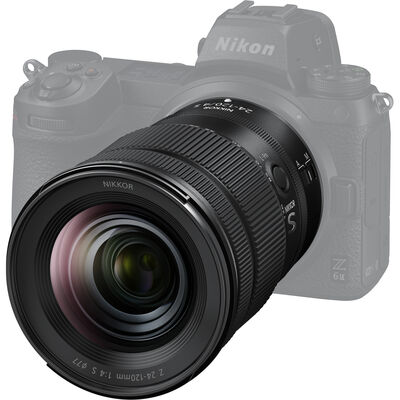
Optical Design
- Featuring a combination of three ED elements, one aspherical ED element, and three aspherical elements, both chromatic and spherical aberrations are effectively eliminated throughout the zoom range for notable sharpness and clarity.
- ARNEO and Nano Crystal Coats are used to prevent ghosting, reflections, and flare in order to realize improved contrast and clarity when working in strong lighting and backlit conditions. The Nano Crystal Coat controls incidental light from a diagonal direction while the ARNEO Coat controls incidental light from a vertical direction.
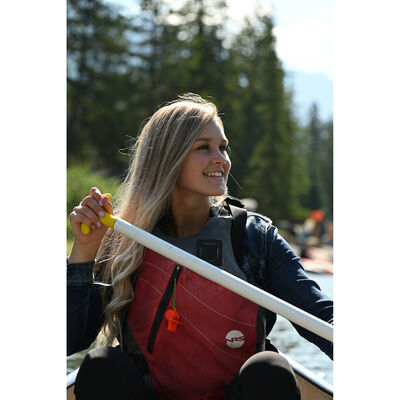
Autofocus
- Multi-focus system incorporates two separate AF drive units, which are synchronized, to deliver especially fast and accurate focusing throughout the zoom range. This system uses stepping motors, which offer impressively smooth and quiet autofocus performance that is well-suited to both stills and video applications.
- Full-time manual focus override is also possible and an internal focusing design is used, where only the internal lens groups are moved during focusing, to maintain the overall length of the lens during use and to promote faster focusing speeds.
- Dedicated manual focus ring at the rear of the lens for tactile and precise control over the focus position.
- Minimum focusing distance of 1.1', along with a maximum magnification of 0.39x, benefits working with close-up subjects.

Handling and Design
- Programmable Control Ring can be used to control aperture, ISO, or exposure compensation.
- Assignable L.Fn button works in conjunction with camera-based Fn buttons to provide seamless points for quickly changing exposure settings and other functions.
- Dust- and moisture-resistant lens barrel, along with a front fluorine coating, benefits the lens' use in inclement conditions.

Falcam F22&F38&F50 Quick Release Foldable Half Cage C00B3808
Key Features
- Two Rotating Shaft Designs
- Compatible with F22, F38 and F50 Quick Release System
- 1/4"-20 Threaded Holes
- ARRI Locating Holes &Strap Holes
- Wire Clamp Locating Holes
- Anti-mistouch & Anti-deflection Design
- Ultra-portable Foldable Design
- Half Cage's Flat State (maximum lever) Can Bear 4.5kg
- Fit Multiple Camera Models
Overview
The Falcam Foldable Half Camera Cage offers a versatile solution for various shooting scenarios. It features a unique dual-axis design that allows you to adjust the angles of the top, side, and bottom plates with ease, transforming it from a full cage into a half-cage configuration. The half-cage's bottom plate is equipped with an F38 quick-release interface, enabling effortless camera assembly and disassembly.
This cage is compatible with the F22, F38, and F50quick-release systems, offering a range of attachment options such as 1/4" threaded holes, ARRI locating holes, wire clamp locating holes, strap holes, and cold shoe mounts to meet diverse expansion needs. It features a double-locking mechanism for enhanced stability, ensuring your camera stays securely in place.
The Falcam Foldable Half Camera Cage is compatible with a wide range of cameras, including Sony, Canon (R5/R6/R7/R10), Nikon (Z5/Z50/Z6/Z60/Z7), Fuji (XT series, XH series), and more. For certain blocky camera models like the Nikon Z8/Z9, the cage offers a unique vertical top plate installation method, similar to an L bracket.
With the option to pair it with Falcam F22, F38, F50, or quick release accessories, you'll experience seamless and fast transitions between different photography scenarios. Don't miss the opportunity to make your photography more versatile and efficient with the Falcam Foldable Half Camera Cage.
Camera Compatibility List
- Sony: A7 IV, A7R V, A7S III, A7 III, A7R IVa, A7R IIIa, A7C, A7C2, A6700, A6600, A6400, A6100, ZV-E1, ZVE-10, ZV1, FX3, FX30
- Fujifilm: X-T1, X-T2, X-T3, X-T4, X-T5, X-T20, X-T30, X-S10, X-S20, H1, X-H2S
- Lumix: S5, S5MK2, S5M2X, G9, DH6A, GH6L, G95D, G7, G100K
- Canon: R5, R6, R6MK2, R7, R8, R10
- Nikon: ZFC, Z30, Z5, Z50, Z6, Z60, Z7
- Sigma: FP, FPL
- Olympus: E-M10, OM-5, OM-1
Nikon NIKKOR Z 600mm f/6.3 VR S Overview
Key Features
- Full-Frame | f/6.3 to f/32
- Handheld Super-Telephoto Prime
- Multi-Focus System
- 5.5-Stop VR Image Stabilization
- Customizable Control Ring
- Size-Reducing Phase Fresnel Element
- ED and SR Elements
- Nano Crystal Coating
- Dust- and Water-Resistant Design
An engineering marvel of miniaturization, the NIKKOR Z 600mm f/6.3 VR S Lens, the latest super-telephoto, full-frame, mirrorless prime from Nikon, delivers premium optical resolution in a handheld build less than half the weight of its predecessor. Powered by a size-reducing Phase Fresnel element, the lens is under a foot long and features a front filter thread of 95mm, making it ideal for sports, wildlife, and action photographers craving optimal imagery without compromising valuable kit space.
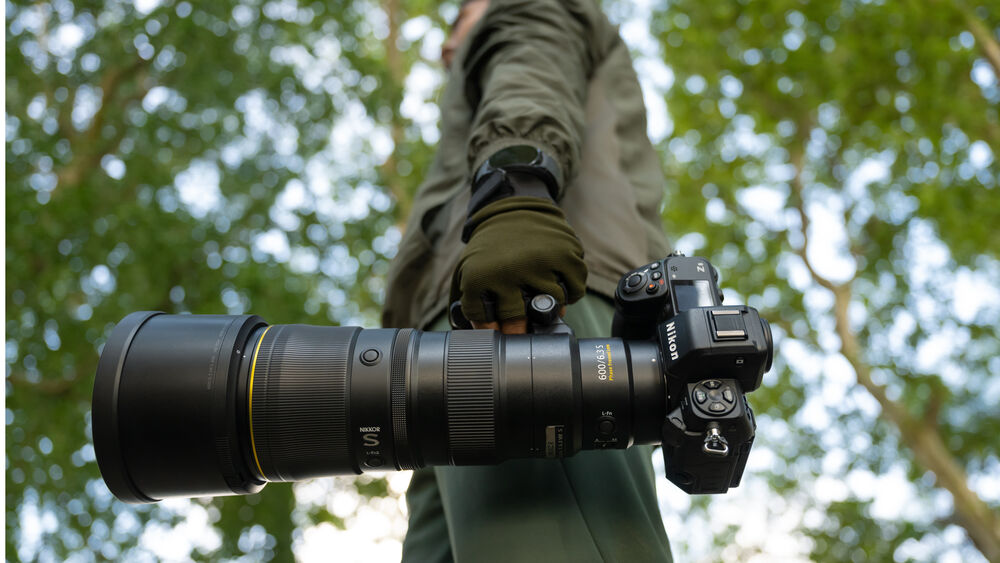
Comfort, Clarity, Handheld Carry
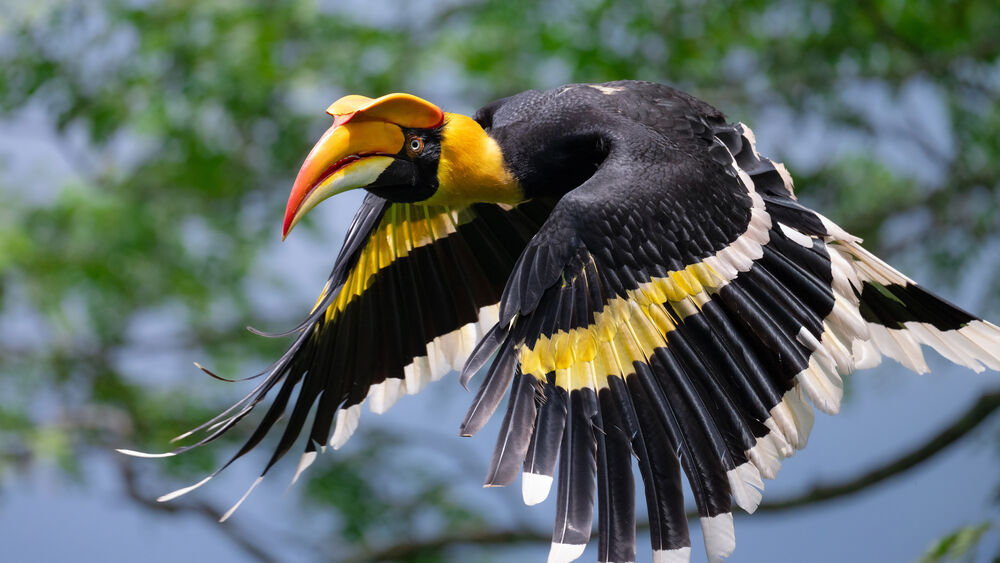
At two-thirds the length and less than half the size of the previous version, the NIKKOR Z 600mm f/6.3 VR S achieves its carry-around design and precision, S-series optical resolution through the introduction of a Phase Fresnel element in the lens and reducing the lens' maximum aperture to f/6.3. Small enough to fit in most kit bags even when attached to a camera body, the lens' 95mm front thread enhances its versatility by allowing the use of light-altering filters. Two extra-low dispersion elements and a short-wave refractive element reduce chromatic aberrations and prevent light dispersion, while the Nano Crystal Coating helps reduce flare and improve clarity, especially with point lights like stars and city lights.
VR Image Stabilization and Autofocus
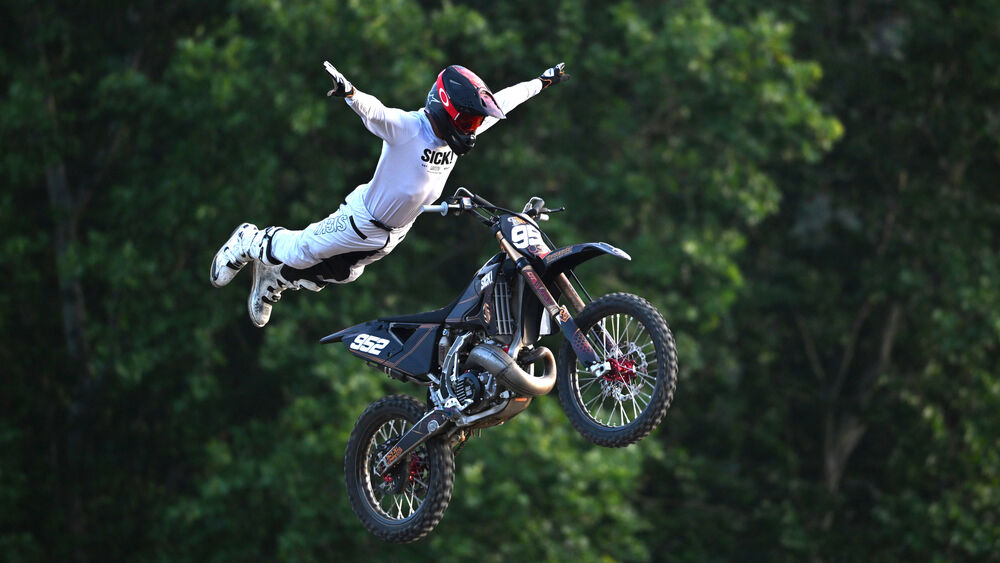
Vibration Reduction
As if handheld carry wasn't enough, Nikon has furnished further encouragement for freewheeling shooters with the lens' built-in optical Vibration Reduction, which achieves up to 5.5 stops of image stabilization on all Z series cameras. With cameras that support Synchro VR, such as the Nikon Zf, Z8, and Z9 mirrorless cameras, a crucial extra half-stop is gained in image stabilization, the equivalent of shooting at a shutter speeds up to 6 stops faster.
Autofocus
The lens' autofocus is powered by the Nikon Stepping Motor, a near-silent AF drive system designed to keep up with fast, erratic subjects like birds and motorsports. The absence of mechanical noise greatly benefits the use of Continuous AF when tracking subjects while taking video. Additionally, focus breathing is suppressed and a precision electromagnetic diaphragm allows for smooth, step-less aperture adjustments while recording.
Body, Handling, and Ergonomics
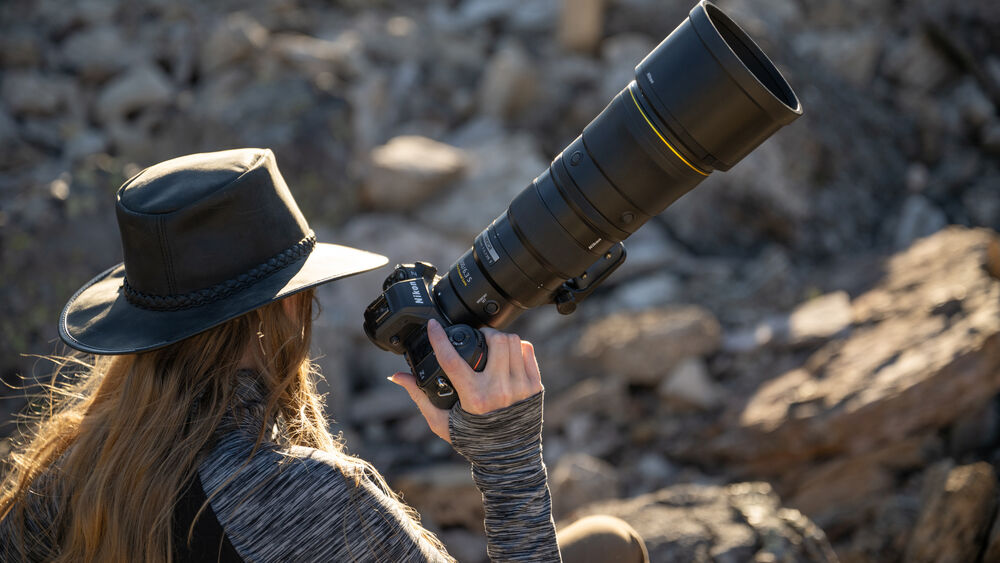
While the drastic size reduction grabs the design and engineering spotlight, a number of customizable controls are also effectively distributed about the lens for both ergonomics and efficiency:
- The lens' center of gravity has been shifted toward the rear of the lens and nearer to camera body, benefitting quick stops and accelerations during handheld panning and allowing for the tracking and acquisition of fast-moving subjects.
- Two programmable function buttons, a control ring, a Memory Set button, and a limiter switch put precision control at your fingertips, with the tactile details that allow for quick adjustments without looking.
- The front rubber grip encourages a stable, comfortable shooting posture in any configuration, while the tripod collar smoothly rotates for shooting in any orientation.
- The use of an optional Z series teleconverter can extend the focal length to up to 1200mm, while the in-camera DX Crop mode increases your angle of view by 1.5x.
- The lens' advanced weather sealing is rated to keep dust, dirt, and moisture out of moving parts for safe use in the elements, while a Kensington Security Slot keeps your lens safe from theft with the use of optional pro-grade cable locks.

- ‹‹
- ‹
- 1
- ›
- ››
